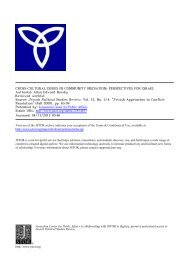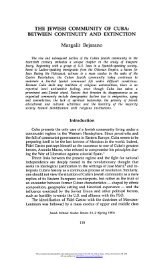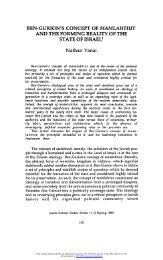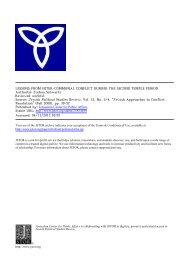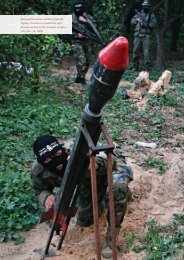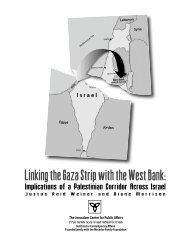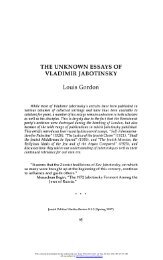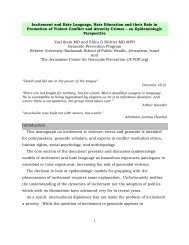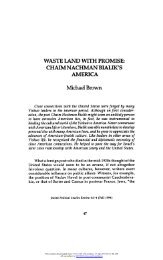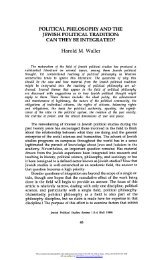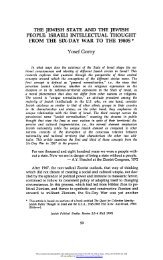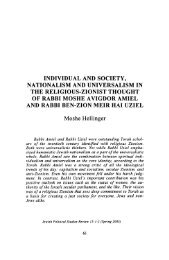the regeneration of french jewry - Jerusalem Center For Public Affairs
the regeneration of french jewry - Jerusalem Center For Public Affairs
the regeneration of french jewry - Jerusalem Center For Public Affairs
You also want an ePaper? Increase the reach of your titles
YUMPU automatically turns print PDFs into web optimized ePapers that Google loves.
THE REGENERATION OF FRENCHJEWRY: THE INFLUX ANDINTEGRATION OF NORTH AFRICANJEWS INTO FRANCE, 1955-1965Michael M LaskierThis article grapples with <strong>the</strong> impact <strong>of</strong> communal self-liquidation <strong>of</strong>North African Jewry in general and <strong>the</strong> Algerian diaspora in particular,during <strong>the</strong> 1950s and 1960s, based on new, primarysource materials ? <strong>the</strong>emigration destination being France. The influx and integration <strong>of</strong> NorthAfrican Jews into France during this period provoked a revolution in <strong>the</strong>French Jewish community, leading to <strong>the</strong> demographic domination <strong>of</strong> <strong>the</strong>North African Jewish component <strong>of</strong> French Jewry, after that communitywas dominated for many years by <strong>the</strong> Germanic and Eastern Europeancomponents. What were some <strong>of</strong><strong>the</strong> causes for emigrationinto France?What challenges were posed by French society for <strong>the</strong> new arrivals? Whatwere <strong>the</strong> emigrants' contributions to <strong>the</strong> geographical expansion <strong>of</strong>FrenchJewry, and to Jewish communal life in France? These and o<strong>the</strong>r aspectsfeaturedin this studyare parta <strong>of</strong>book manuscript in progress, entitled:The Jews <strong>of</strong> France and <strong>the</strong>ir Social and Political Transformation:1945-1995Jewish Political Studies Review 10:1-2 (Spring 1998)37This content downloaded by <strong>the</strong> authorized user from 192.168.52.70 on Sun, 18 Nov 2012 07:27:10 AMAll use subject to JSTOR Terms and Conditions
38 Michael M. LaskierThe BackgroundJews from Morocco, Tunisia and Algeria beganto settle in Franceas <strong>the</strong> Muslim nationaliststrugglefor North African liberation fromFrance gainedmomentum.Firmly rooted in <strong>the</strong>ir milieu, <strong>the</strong> MaghribiJewish communities were not politicallyor economicallysecure and<strong>the</strong> French colonial era in North Africa wasdrawingto a close.Beginningin 1955, an exodus <strong>of</strong> Jewish emigrantsandrefugeescommenced in <strong>the</strong> direction <strong>of</strong> Israel and France.By 1962-63, emigration had become large-scale.After Francegranted Algeria independencein <strong>the</strong> summer <strong>of</strong>1962, integration <strong>of</strong> Algerian-Jewish emigrants emergedas <strong>the</strong> toughest challenge for <strong>the</strong> French-Jewish communities.Ninety percent <strong>of</strong>Algeria's Jewish population, 120,000 people,fled to France; <strong>the</strong>y hadrealized that <strong>the</strong>ir prospectsfor a sound economic future in anindependent MuslimAlgeriawere not good,and<strong>the</strong>y were Frenchcitizensby virtue <strong>of</strong> <strong>the</strong> Cremieux Decree <strong>of</strong> October 24, 1870. Incontrast, only 10,000 Jews headed for Israel.In a matter <strong>of</strong> months, beginningin <strong>the</strong> latter half <strong>of</strong> 1962, a newgeography<strong>of</strong> <strong>the</strong> French Jewish communitywas created. Communities whichformerly numbered a modest 500 families or less expandedto include more than 4,000 families in 1963. While <strong>the</strong> overallpopulation<strong>of</strong> France increased by less than 1.5 percent with <strong>the</strong>influx <strong>of</strong> French and o<strong>the</strong>r European repatriates from Algeria, by1965 <strong>the</strong> French Jewish communities increasedby 40 percent. Thistremendouspopulation growth, with <strong>the</strong> additional influx <strong>of</strong> Jewishrefugeesfrom Morocco and Tunisia, transformed FrenchJewry by1970 into <strong>the</strong> secondlargest Jewish communityin <strong>the</strong> WesternWorld, with over 550,000 people.What did FrenchJewry do to receive and absorb <strong>the</strong> Maghribinewcomers? Who financed <strong>the</strong>ir resettlement? Where did <strong>the</strong>ysettleand how did<strong>the</strong>ycoexist with <strong>the</strong> once predominantlyAshkenazicommunities? After all, by <strong>the</strong> mid-1960s, after one decade <strong>of</strong> steadyemigrationto France, <strong>the</strong> Maghribi Jewish segment emergedas <strong>the</strong>majority<strong>of</strong> <strong>the</strong> French Jewish population.The effort to assist <strong>the</strong> newcomers waslargely undertaken bytwo organizations: <strong>the</strong> American Jewish Joint Distribution Committee (AJDC) and <strong>the</strong> Fonds Social Juif Unifie (FSJU). The AJDC, whosemain centers <strong>of</strong> operationwere in New York, Paris, and Geneva, wascreated in 1914 by American Jews <strong>of</strong> German origin. Its functions,operating overseas, includedsubsidizing Jewish communal institutions throughout<strong>the</strong> world, financing Jewish emigrationto Israel,Europe,and <strong>the</strong> United States, and providing assistance, food, andThis content downloaded by <strong>the</strong> authorized user from 192.168.52.70 on Sun, 18 Nov 2012 07:27:10 AMAll use subject to JSTOR Terms and Conditions
The Influx and Integration <strong>of</strong> North African Jews into France 39clothingfor impoverished Jews ? refugees and non-refugeesalike.It was funded largely by <strong>the</strong> United Jewish Appeal (UJA).The AJDChad operatedin France since 1944, commencingimmediatelyafter <strong>the</strong> country'sliberation from <strong>the</strong> Germanoccupationand Vichyrule. <strong>For</strong> <strong>the</strong> first year and a half it emphasized meetingemergency requirementsin communitiesseriouslydevastatedbyWorld War II. By 1946, however, although <strong>the</strong> AJDC still encountered innumerable emergency problems,and contended with a largeinflux <strong>of</strong> refugees from EasternEurope,it began workingwithleaders <strong>of</strong> FrenchJewry as well as with local welfare organizationsto make <strong>the</strong>ir programs self-sufficient. In fact, <strong>the</strong> AJDC soughttopromotein <strong>the</strong> French communitiessophisticated fundraisingtechniquesused in <strong>the</strong> United States and, simultaneously,to conveyaclear message: AJDC operationsin France would not continue indefinitely.The combined efforts <strong>of</strong> <strong>the</strong> AJDC in France and localJewryresulted in <strong>the</strong> establishment, in 1949, <strong>of</strong> <strong>the</strong> FSJU. Modeled to someextent on America's UJA, <strong>the</strong> FSJU's two major objectiveswere: tocollect, on behalf <strong>of</strong> local Jewish agencies,funds for maintaininganddevelopingactivities as well as to seek o<strong>the</strong>r means <strong>of</strong> financing thisend; and, as a central distributing body,to allocate <strong>the</strong> funds toaffiliated agencies.In March 1960, Baron Guy de Rothschild, president <strong>of</strong> <strong>the</strong> FSJU,acknowledgedAmericanJewry's and <strong>the</strong> AJDC's contribution toward <strong>the</strong> development<strong>of</strong> this organization:...basing ourselves moreparticularlyon <strong>the</strong> American experience which is morecomplete,older and financiallybetter supported, we thought that it would be wise to establish a uniqueassociationcomprisingif possibleall social and cultural institutions which were not exclusively religious institutions, with aview to coordinating <strong>the</strong>m in a collective and unified effort.We understood what America had known for a longtimealreadyand wassharingwith us. We understood that it was notpossible to ga<strong>the</strong>r significant amounts <strong>of</strong> money without doing itin a logicaland organizedmanner....We understood that what nosingle one <strong>of</strong> <strong>the</strong> federated agenciescould do on its own, wewould be able to achieveby constitutinga federation <strong>of</strong> <strong>the</strong>reasonagencies....The[our] tenth anniversaryis an expression<strong>of</strong>real achievement, is that we had set ourselves <strong>the</strong> task <strong>of</strong> becoming <strong>the</strong> Jewish community<strong>of</strong> France ? on <strong>the</strong> social as planewellas on <strong>the</strong> culturalplane ? and we succeeded.1This content downloaded by <strong>the</strong> authorized user from 192.168.52.70 on Sun, 18 Nov 2012 07:27:10 AMAll use subject to JSTOR Terms and Conditions
40 Michael M. LaskierThe FSJU gradually adopted modern fundraising techniques,includingbenefit dinners, personal solicitations, massappealsthroughletters and o<strong>the</strong>r printed materials, and publicity throughL'Arche, <strong>the</strong> organization's monthly journal. Yet, notwithstanding<strong>the</strong> gradual expansion<strong>of</strong> <strong>the</strong> FSjU to <strong>the</strong> benefit <strong>of</strong> local communalagenciesas well as refugees,in 1961 and 1962 French Jewry continued to depend considerablyon <strong>the</strong> AJDC. In 1962, France remained<strong>the</strong> largest European operation<strong>of</strong> <strong>the</strong> AJDC. It had <strong>the</strong> largestbudgetand it assisted <strong>the</strong> largest Jewish communityin?Europe240,000 Jews in 1961 and 1962.Indeed, <strong>the</strong> AJDC and FSJU were confronted by a serious challenge in France. Alreadyin 1944 and 1945 <strong>the</strong> French Jewish communities, consisting<strong>of</strong> over 200,000 Jews, were <strong>the</strong> onlyones outsideIsrael to be inundatedby consecutive waves <strong>of</strong> immigrants.TheFrenchgovernment'sliberal policy<strong>of</strong> keeping<strong>the</strong>gates open torefugees meant that <strong>the</strong> Jewish communities in France became havens for those who had fled <strong>the</strong>ir homelands for Western Europe.Hundreds <strong>of</strong> thousands <strong>of</strong> refugeesweregranted temporary asylum, pending permanent resettlement elsewhere. However, tens <strong>of</strong>thousandspreferredto make France <strong>the</strong>ir permanent home. Nei<strong>the</strong>rtemporarynorasylumresettlement could have been undertaken had<strong>the</strong> French governments <strong>of</strong> <strong>the</strong> fourth and fifth republicsnot assisted. Notonly had drastic changesoccurred in French-Jewishgeographyanddemography, but significantsocioeconomic andcultural transformations createdproblemswhich remained unresolved for many years.The Arrival <strong>of</strong> North African Jews in France, 1955-1965Althoughmore than two-thirds <strong>of</strong> Morocco's and half <strong>of</strong> Tunisia'sJewry emigrated to Israel via Europe through <strong>the</strong> initiative <strong>of</strong> <strong>the</strong>Jewish Agency, many o<strong>the</strong>rs settled in France and Canada.AlgerianJewry, on <strong>the</strong> o<strong>the</strong>r hand, settled after 1962 mostlyin France, withonly 10 percent havingchosen Israel as <strong>the</strong>ir new permanent home.2During<strong>the</strong> summer <strong>of</strong> 1955, when Tunisia wasgranted internalautonomy by <strong>the</strong> French as a decisive step toward full independenceand in <strong>the</strong> wake <strong>of</strong> Morocco'sstruggle for independence, Jews leftfor France.They soughtrelief and assistance from French Jewishagencies subsidizedby <strong>the</strong> AJDC and FSJU. Among<strong>the</strong>se agencieswere <strong>the</strong> Comite Juif d'Action Sociale et de Reconstruction(COJASOR), <strong>the</strong> Comite de Bienfaisance Israelite de Paris (CBIP),known since 1963 as <strong>the</strong> Comite d'Action Sociale Israelite de ParisThis content downloaded by <strong>the</strong> authorized user from 192.168.52.70 on Sun, 18 Nov 2012 07:27:10 AMAll use subject to JSTOR Terms and Conditions
The Influx and Integration <strong>of</strong> North African Jexvs into France 41(CASIP), and <strong>the</strong> Service Social de Jeunes (SSJ), which attended torefugee youths.The data availablefor 1955 is sketchyat this stage <strong>of</strong> our research.Never<strong>the</strong>less, this information is indicative <strong>of</strong> <strong>the</strong> socioeconomicchallengeswhich confronted <strong>the</strong> subsequent Maghribinewcomers.Take, for instance, <strong>the</strong> fifty-nine newlyarrived families, 196 persons,whichapproached<strong>the</strong> CBIP betweenJulyand October 1955. Thesefamilies received cash relief benefits from <strong>the</strong> CBIPalthough <strong>the</strong>yappearedto be employableand to have sufficient funds for livingexpenses. They had liquidated<strong>the</strong>ir assets in Morocco, Tunisia andAlgeriain order to pay <strong>the</strong>ir passage to France, and <strong>the</strong> overwhelming majority had relatives in Paris whoprovided initiallivingaccommodations. Moreover, <strong>the</strong> French labor market in 1955 wasstable, many <strong>of</strong> <strong>the</strong>se peoplewho were skilledpr<strong>of</strong>essionalsmanagedto secureemploymentwith relative ease.3Of <strong>the</strong>se 196 persons 60 percentwere Tunisians, 30 percentwereAlgerians,and 10 percentwere Moroccans.4 It is unclear whe<strong>the</strong>r <strong>the</strong>Tunisian element included in its ranks several Jews who were Frenchcitizens eventhoughmost <strong>of</strong> <strong>the</strong>m were doubtless Tunisian nationals. Byvirtue <strong>of</strong> <strong>the</strong> 1923 FrenchCitizenship Law, one-fourth <strong>of</strong>Tunisia'sJewry obtained French citizenship during<strong>the</strong> French Protectorate era. Those whoenjoyedthis privilegealso became beneficiaries <strong>of</strong> substantial French governmental assistance, <strong>the</strong> type <strong>of</strong>assistance French Jewish organizationsor relatives could not alwaysprovide. Algerian Jews, French citizens, also becamerecipients <strong>of</strong>such aid. The Moroccan element, however, wascompletely dependent on relatives and Jewish relief agencies,for <strong>the</strong>yweresubjects<strong>of</strong> Morocco's Sherifian Sultan. The French <strong>of</strong>ficials in Moroccorefrained throughout<strong>the</strong> colonial era from granting citizenshipto<strong>the</strong> Jews.Whereas <strong>the</strong>se fifty-ninefamilies fared well and became integratedinto Frenchsociety,this was <strong>the</strong> exception ra<strong>the</strong>r than <strong>the</strong>rule. Alreadyin 1955 <strong>the</strong> real problem facingnewcomers was housing. The initial conditions under which <strong>the</strong>ylived with relativeswere extremely difficult, with eight to ten people per room; in onecase, seventeenwerepeopleconfined to one room. When <strong>the</strong>irrelatives could no longerhost <strong>the</strong>m, <strong>the</strong> North African newcomerswereforced to rent hotel rooms for 10,000 to 12,000 Francs per monthfor one room. This meant that a disproportionate part<strong>of</strong> <strong>the</strong>ir budgetwas used for rent butlivingconditions remained crowded. Theovercrowdingresulted in a rapiddeterioration in familyrelationa rareships, phenomenonin <strong>the</strong>ir countries <strong>of</strong> origin,as well ashealthproblems. Fur<strong>the</strong>rmore, most hotels would not accept smallThis content downloaded by <strong>the</strong> authorized user from 192.168.52.70 on Sun, 18 Nov 2012 07:27:10 AMAll use subject to JSTOR Terms and Conditions
42 Michael M. Laskierchildren and in numerous instances <strong>the</strong> families placed<strong>the</strong>m with<strong>the</strong> French Assistance Publique.5In May 1956, plans were drawn in <strong>the</strong> French Jewish communityto absorb <strong>the</strong> growinginflux <strong>of</strong> North African Jews. An emergencymeetingwas convened by Jacob Kaplan,<strong>the</strong> Chief Rabbi <strong>of</strong> France,held at Guyde Rothschild's <strong>of</strong>fice, and attendedby representatives<strong>of</strong> <strong>the</strong> AJDC, FSJU and o<strong>the</strong>r major organizations.It wasagreed thatin light<strong>of</strong> <strong>the</strong> deteriorating conditions <strong>of</strong> <strong>the</strong> North African Jewish?populations especiallyin Algeria where a bloody civil war againstFrench rule victimized <strong>the</strong> Jews as it did <strong>the</strong> Muslims and Europeansettlers ? a coordinating <strong>of</strong>fice for resettlement research would beestablished in Paris. The FSJU took <strong>the</strong> responsibilityfor findingacapableindividual to head <strong>the</strong> <strong>of</strong>fice. Under <strong>the</strong> aegis<strong>of</strong> <strong>the</strong> CentralConsistory,<strong>the</strong> leading Jewish communal andreligious organization, a study<strong>of</strong> housingandemployment opportunitiesin <strong>the</strong>provincialcommunities was to be preparedfor families that wereabout to departfrom North Africa. Once <strong>the</strong> data on <strong>the</strong>se issueswerecompiled,it would be forwarded to <strong>the</strong> coordinating<strong>of</strong>ficewhich, in turn, wouldrelayit to <strong>the</strong> North African communities forthose anxious to reach France.6It washopedthat <strong>the</strong> coordinating<strong>of</strong>fice would also serve as aninformation and guide bureau for newcomers and wouldhelp createa reception committee at <strong>the</strong> port <strong>of</strong> Marseilles, one <strong>of</strong> <strong>the</strong> main portswhere <strong>the</strong> North Africans arrived. Already<strong>the</strong> leaders <strong>of</strong> FrenchJewry, like <strong>the</strong> French government, encouraged<strong>the</strong> resettlement <strong>of</strong>emigrants andrefugeesinto <strong>the</strong> provinces ra<strong>the</strong>r than in Paris,hopingto avoid over-concentration in <strong>the</strong> capital where <strong>the</strong> housingshortage was particularlyacute. Moresignificantly, however, <strong>the</strong>Jewish leadershipin France aspiredto streng<strong>the</strong>n<strong>the</strong> small communities in <strong>the</strong> provinces.7Present at <strong>the</strong> meetingwasEugene Weill, secretary-general<strong>of</strong> <strong>the</strong>Alliance Israelite Universelle. He maintained that as <strong>the</strong> number <strong>of</strong>North African Jewish newcomers would increase, <strong>the</strong> major challenge would be integrating<strong>the</strong> Moroccans and Tunisians, most <strong>of</strong>whom were not French citizens. On <strong>the</strong> o<strong>the</strong>r hand, Algerian Jews,French citizens for <strong>the</strong> mostpart, would become more integratedand could be eligiblefor substantial Frenchgovernmental assistance. Weillpredicted accuratelythat <strong>the</strong> largest group <strong>of</strong> NorthAfrican Jews would not come from Tunisia and Morocco, but fromAlgeria. This, he attributed to <strong>the</strong> growingtrend <strong>of</strong> Moroccans andTunisianssettlingin Israel.8We found no fur<strong>the</strong>r evidencepertainingto <strong>the</strong> coordinating<strong>of</strong>fice and its goal <strong>of</strong> facilitating<strong>the</strong> absorption<strong>of</strong> North Africansinto <strong>the</strong>ir new geography.What seems certain is that <strong>the</strong> economicThis content downloaded by <strong>the</strong> authorized user from 192.168.52.70 on Sun, 18 Nov 2012 07:27:10 AMAll use subject to JSTOR Terms and Conditions
The Influx and Integration <strong>of</strong> North African Jem into France 43and political fortunes <strong>of</strong> North AfricanJewry, especially those inTunisia, took a serious turn for <strong>the</strong> worse in 1961 and 1962. The antiFrench manifestations <strong>of</strong> Tunisia's president Habib Bourguiba, and<strong>the</strong> continuingcrisis in Algeria,resulted in a flood <strong>of</strong> refugeestoFrance. This influx overwhelmed FrenchJewry and brought aboutdemographic changesin <strong>the</strong>ir midst.Although<strong>the</strong> Jewish communities in Tunisia wererelatively well<strong>of</strong>f underBourguibafrom <strong>the</strong> years 1956 to 1961, immediatelyfollowing independence, and <strong>the</strong>ir freedom <strong>of</strong> movement was respected,this situationchanged radicallyin <strong>the</strong> summer <strong>of</strong> 1961 inconnection with <strong>the</strong> Bizerte crisis. In July, Bourguiba demanded thatFrench President Charles de Gaulle evacuate France's bases atBizerte, bases whichrepresented<strong>the</strong> last vestigespast. Tunisia's insistence over Bizertedeveloped<strong>of</strong> <strong>the</strong> colonialinto full-scalefighting and resulted in a massacre <strong>of</strong> Tunisian civilians, a militarydefeat for Tunisia, but no evacuation until de Gaulle's decision(which would probablyhave been made in any event) more than twoyears later.<strong>For</strong> <strong>the</strong> Jews, <strong>the</strong> Bizerte crisis precipitated emigration.In 1960,only 1,800 left for Israel and France, but from <strong>the</strong> end <strong>of</strong> July untilmid-September 1961, 3,500 arrived in France. Thisfigure does notinclude 500 to 600 in transit at Marseilles on <strong>the</strong>ir way to Israel. TheMossad, Israel's secret service apparatus,in collaboration withFrench military personnelon active dutyon Tunisian soil, evacuatednumerous Jews from trouble spots and transported<strong>the</strong>m out <strong>of</strong> <strong>the</strong>country. Of <strong>the</strong> 3,500 who arrived in France, 2,000 held Frenchpassports while <strong>the</strong> remainder were Tunisian nationals. The latterwerecategorizedas refugees partlybecauseBourguiba prohibitedexport <strong>of</strong> possessionsandcapital. Jews with French passports,accordingto AJDC sources in Tunisia, were able to register<strong>the</strong>irproperty with <strong>the</strong> French consuls and thus draw up an inventory.Insome cases<strong>the</strong>y openedbank accounts abroad or had families inFrance to whom<strong>the</strong>y could turn for assistance. Jews <strong>of</strong> Tunisiannationality,on <strong>the</strong> o<strong>the</strong>r hand, had no consul to whom<strong>the</strong>y couldturn and were unable to take money with <strong>the</strong>m upon departure.9Actually,<strong>the</strong> French nationals who left Tunisia or were evacuated ? Jews and non-Jews alike ? also enjoyedcertain privilegesinFrance. The French government organized complete receptionservices that included emergency housing,financial aid, and employment assistance. Once employmenthad beenprocured,loans forindependentbusinesses and assistance for government housingweregranted.The French governmentestablished a Secretariat deRapatriesto organize<strong>the</strong> integration process <strong>of</strong> French repatriates.10This content downloaded by <strong>the</strong> authorized user from 192.168.52.70 on Sun, 18 Nov 2012 07:27:10 AMAll use subject to JSTOR Terms and Conditions
44 Michael M. LaskierTunisian Jews <strong>of</strong> French nationality, <strong>the</strong>n, did not pose particularproblemsfor <strong>the</strong> local French-Jewish communities. With respect to<strong>the</strong> 1,500 Jews <strong>of</strong> Tunisian nationality who had reached FrancebySeptember 1961, and subsequent newcomers, it was an entirelydifferent matter. Government services were not available for refu<strong>of</strong> Tunisiannationality,nor did <strong>the</strong> Service Social d'Aide auxgeesEmigrants (SSAE) appear to possess <strong>the</strong> financial resources for <strong>the</strong>m.A serious problemthus emerged:whereas Jews <strong>of</strong> Tunisian nationality had <strong>the</strong> right to work and did not have a language barrier, asdid mostimmigrants from EasternEurope, <strong>the</strong>ynone<strong>the</strong>less wereexcluded from governmental welfare, medical and similar assistance. Consequently,<strong>the</strong> support<strong>of</strong> <strong>the</strong> FSJU's and AJDC's subsidized aid organizationsbecamenecessary.11According to information provided by <strong>the</strong> FSJU, its personnelhad a modest booth at <strong>the</strong> port <strong>of</strong> Marseilles for <strong>the</strong> Tunisianrefugees. On September 1,1961, a jointventure <strong>of</strong> <strong>the</strong> Committee <strong>of</strong>North African Jews in France and FSJU createdreception bureaus(bureaux d'accueil) in Marseilles and Paris. In later years <strong>the</strong> bureauxwere instrumental in assisting<strong>the</strong> large-scale absorption<strong>of</strong> AlgerianJews. Eventually,<strong>the</strong> bureaux assisted <strong>the</strong> refugeesin five areas:reception, housing, relief (cash assistance, care for <strong>the</strong> aged, childcare), religious/educational/cultural endeavors, and employment.The French governmentalconnection here wasindispensablein onlyone major aspect: <strong>the</strong> authorities granted<strong>the</strong> Tunisian (and Moroccan) refugees<strong>the</strong> "right <strong>of</strong> asylum,"a moralprotection ra<strong>the</strong>r thanan effective administrativeprivilege. Some Tunisians arrived withvisitors' visas granted by<strong>the</strong> French consulate in Tunis. The visaswere valid for three months and weresubsequentlyconverted toresidencepermits.12The activities <strong>of</strong> <strong>the</strong> bureaux d'accueil in Marseilles and Paris weresimilar, although<strong>the</strong> greatest responsibilityrested on <strong>the</strong> bureau inMarseilles. About 85 percent <strong>of</strong> <strong>the</strong> Algerian newcomers, as well as<strong>the</strong> Moroccan and Tunisianrefugees, entered France via Marseilles.Beginningin 1962, <strong>the</strong> reception <strong>of</strong> newcomers extended into provincial towns such as Lyon, Toulouse, and Strasbourg, where<strong>the</strong>ywere guided by representatives <strong>of</strong> <strong>the</strong> FSJU in cooperation with localveteran communities.13Supplementing <strong>the</strong> role <strong>of</strong> <strong>the</strong> bureaux in 1961 and 1962 was <strong>the</strong>aforementioned CBIP/CASIP cash relief agency, subsidized by <strong>the</strong>FSJU and AJDC. Its role was <strong>of</strong> immeasurableimportanceto Tunisian Jews in Parisfollowing<strong>the</strong> Bizerte crisis. <strong>For</strong> example,inAugust 1961, 106 Tunisian-Jewish families ? 405?werepeopleassistedby this agency. Added to <strong>the</strong> sharpincrease <strong>of</strong> new Tunisianrefugees,<strong>the</strong> number <strong>of</strong> Moroccan and Algeriannewcomers had alsoThis content downloaded by <strong>the</strong> authorized user from 192.168.52.70 on Sun, 18 Nov 2012 07:27:10 AMAll use subject to JSTOR Terms and Conditions
The Influx and Integration <strong>of</strong> North African Jews into France 45increased. Whereas at <strong>the</strong> beginning<strong>of</strong> 1961 <strong>the</strong> CBIP/CASIP received an average <strong>of</strong> ten Algerianfamilies per month. In August,CBIP/CASIP figures showed twenty-one Jewish families ? 105persons ? who appliedfor cash relief14 (see Table 1). During 1962,<strong>the</strong> CBIP/CASIP received in Paris nearly 2,700 Algerian-JewishTable 1NORTH AFRICAN JEWS REGISTERED WITH CBIP:AUGUST 1,1961 - NOVEMBER 30,1961Month From Tunisia From Morocco From AlgeriaCases People Cases People Cases PeopleAugust1084052110540 188September1544982216327 141October201585205660 240November153612166470 280Total616 2,100 78 288 197 849Source: E. Odenwald-Kremsdorf to Dr. Sidney Nelson, Paris, December 9,1961, Arch. AJDC/<strong>Jerusalem</strong>, 382B.families whorepresented 12,000 people, 1,000 Tunisian familiesconsisting <strong>of</strong> 4,000 people, and 180 Moroccan families, totalling 600people.15The benefits grantedto North African Jews as earlyas 1961included medical and '/medico-social,, programs. WhileAlgerianJews were French citizens and thus eligiblefor <strong>the</strong> French socialsecurity system benefits that covered medical expenses, <strong>the</strong> Tunisians and Moroccans were aidedby<strong>the</strong> French-Jewish medicalOrganisation aux Secours des Enfants (OSE) and <strong>the</strong> Tiomkinedispensaries.These agenciesnot only provided<strong>the</strong> necessarytreatments but covered <strong>the</strong> expenses for drugsand appliances,dentalcare and eyeglasses. AdditionallyTunisian and Moroccan refugeeswho desired to attend French universities wereineligiblefor <strong>the</strong>French governmental scholarships<strong>of</strong>fered to Jewish and non-JewishFrench nationals from Algeria.To ensure that <strong>the</strong>ybenefited fromThis content downloaded by <strong>the</strong> authorized user from 192.168.52.70 on Sun, 18 Nov 2012 07:27:10 AMAll use subject to JSTOR Terms and Conditions
46 Michael M. Laskierhigher education in <strong>the</strong>ir newsurroundings,FrenchJewry createdscholarshipfunds for <strong>the</strong>m.16In Paris, <strong>the</strong> Foyer Amical, a French Jewish AJDC-affiliatedorganization, operateda kosher canteen for refugeeswhich had acapacity <strong>of</strong> 200 persons per seating. Whereas early in 1961 thiscanteen served 600 mealsdaily,in September<strong>of</strong> that year it madeover 900 mealsdailyfor persons who could not o<strong>the</strong>rwise obtaincomplete kosher meals. This expansionwaspartly attributed to <strong>the</strong>influx <strong>of</strong> Romanian-Jewish refugees,but it waspr<strong>of</strong>oundlyinfluenced also b <strong>the</strong> Tunisian-Jewish exodus duringand following <strong>the</strong>Bizerte crisis.17Wealreadyremarked that <strong>the</strong> AJDC and FSJU were <strong>the</strong> most vitalorganizations promotingand subsidizing <strong>the</strong> resettlement <strong>of</strong> NorthAfricans and o<strong>the</strong>r Jews in France. Yet, howpreciselydid<strong>the</strong>yoperate financially?Whichauxiliary agencies outside France supported <strong>the</strong>m?There were three main sources <strong>of</strong> fundingin favor <strong>of</strong> <strong>the</strong> NorthAfrican and o<strong>the</strong>r newcomers. The PoolBudget which <strong>the</strong> FSJUshared with <strong>the</strong> AJDC, had a budget in 1963 <strong>of</strong> more than 7,500,000New Francs (NF henceforth), <strong>of</strong> which <strong>the</strong> AJDC invested 3,500,000NF and <strong>the</strong> FSJU contributed <strong>the</strong> balance. This source allocatedfunds to <strong>the</strong> diverseagencies which dealt with cash relief, canteens,child care, medical and medico-social programs (e.g., OSE), vacation camps, day schools, and youth centers.18 educational and cultural projects (schools as well as religious and secular centers) weresupported by <strong>the</strong> Jewish Claims conference (an international organization created in 1952, which used Germanpost-World War IIindemnification funds to subsidize institutions in Israel and <strong>the</strong>Diaspora)as a supplementto <strong>the</strong> Pool Budget.19The Common Fund was created by <strong>the</strong> AJDC/FSJU during <strong>the</strong>early 1960s. The AJDC participated with <strong>the</strong> FSJU in conjunctionwith variousEuropean Jewish communities, <strong>the</strong> French government, and <strong>the</strong> Jewish Colonization Association (ICA) to advancefunds for <strong>the</strong> North Africans. In 1963 <strong>the</strong> Common Fund budget wasset at 10,000,000 NF, but available funds amounted to only 7,500,000NF. The AJDC invested 2,000,000 NF, <strong>the</strong> FSJU an additional 2,000,000NF, and <strong>the</strong> European Jewish communities and <strong>the</strong> French government provideda combined 1,300,000 NF. There was also a carryoverfrom 1962 <strong>of</strong> approximately 2,2000,000 NF, making a total <strong>of</strong> 7,500,000NF. However, it wasagreedthat <strong>the</strong> AJDC would hold a reserve <strong>of</strong>2,000,000 NF and <strong>the</strong> FSJU a reserve <strong>of</strong> 500,000 NF in case actualexpenditures would exceed <strong>the</strong>se 7,500,00 NF.20The Common Fund provided financial allocations for <strong>the</strong> reception bureaus in Paris and Marseilles which, in October 1963, forThis content downloaded by <strong>the</strong> authorized user from 192.168.52.70 on Sun, 18 Nov 2012 07:27:10 AMAll use subject to JSTOR Terms and Conditions
The Influx and Integration <strong>of</strong> North African Jews into Trance 47instance, received 100 people dailyfrom North Africa. In December1963, <strong>the</strong> Common Fund assisted a total <strong>of</strong> 1,379 North Africans inFrance; in January1964 <strong>the</strong> number reached 1,481, and in February1964, 1,517.21As noted, <strong>the</strong> bureausprovideda widevariety<strong>of</strong> services andemergedas <strong>the</strong> backbone <strong>of</strong> activity, including support for housingand job placement.In 1962 and 1963 <strong>the</strong> bureau'shousing departmentshelped800 families, representingover 3,500 persons. Theyprovidedinterest-free loans for housing (rent or purchase),although outright grants were also given.From November 1962 toMarch 1963, 630 housing loans based on <strong>the</strong> Common Fund weregranted, amountingto 1,900,000 NF, benefiting 3,170 persons.22between March and October 1963, an additional 170 housing loanswere disbursed, benefitingano<strong>the</strong>r 330 North Africans.23Ano<strong>the</strong>r notable contribution <strong>of</strong> <strong>the</strong> Common Fund was <strong>the</strong> work<strong>of</strong> CBIP/CASIP which, between January and August 1964, providedcash relief to 2,100 Tunisian Jews as comparedwith 2,005 during<strong>the</strong>entire year <strong>of</strong> 1963 (see Table 2).24Third, <strong>the</strong> Special Programs assistance fund, an exclusive initiative <strong>of</strong> <strong>the</strong> AJDC, providedassistance to Egyptianand East European Jewish refugees who arrived in France beginningin <strong>the</strong> mid1950s, escaping instability and persecution.25 Accordingto Dr. SidneyNelson, <strong>the</strong> director for AJDC operationsin France, in 1963 <strong>the</strong>re wasstill a group <strong>of</strong> Egyptian Jews in France classified as "integrationcases." Since <strong>the</strong> Sinai/Suez War <strong>of</strong> 1956, 6,000 families, or over23,000 Jews, had been received by <strong>the</strong> AJDC-sponsored COJASORagency.26 From January 1 to March 31,1964, a monthly average <strong>of</strong> 871refugeesfrom Egyptand EasternEuropewere assisted in Francewith AJDC funds, compared to a monthly average <strong>of</strong> 1,278 during<strong>the</strong> first quarter and 998 during<strong>the</strong> fourth quarter <strong>of</strong> 1963. Thus, <strong>the</strong>Special Programsfund was not meant for <strong>the</strong> Moroccans, Tunisians,and Algerians.<strong>For</strong> <strong>the</strong> supporting agenciesit was <strong>the</strong> least burdensome fund <strong>of</strong> <strong>the</strong> three, for it was decreasing following <strong>the</strong> departure<strong>of</strong> East Europeanand Egyptiantransients to o<strong>the</strong>r lands or <strong>the</strong>irsettlementin France.27This content downloaded by <strong>the</strong> authorized user from 192.168.52.70 on Sun, 18 Nov 2012 07:27:10 AMAll use subject to JSTOR Terms and Conditions
48 Michael M. LaskierMonthTable 21964 MONTHLY CASH RELIEF LOAD:TUNISIANS (CASIP)Number <strong>of</strong> Beneficiaries AmountFamilies People NFJanuary18871944,356February19273339,436March16062432,262April18869439,743May20374137,474June20876741,714July19571236,406August15769939,013September21582544,646October3471,493104,818November3151,31886,684December3171,30896,988Source: Budgetand Finance Department, AJC, toCharles H. Jordan Regarding DevelopmentinTunisian Caseload in France, Arch.AJDC/<strong>Jerusalem</strong>, 382B.The Pains <strong>of</strong> Absorption and Integration into <strong>the</strong> NewGeography ? Emphasis on Algerian Jewry: 1962-1965In <strong>the</strong> latter half <strong>of</strong> 1962 <strong>the</strong>re was an overall temporary slowdown in <strong>the</strong> arrival and registration <strong>of</strong> Tunisian and MoroccanJewish refugeesand emigrants,whereas <strong>the</strong> number <strong>of</strong> Jews comingfrom Algeriaincreased. AsearlyasJanuary-February1962 <strong>the</strong>number <strong>of</strong> Algerian Jews who turned to <strong>the</strong> FSJU in Marseillesexceeded that <strong>of</strong> <strong>the</strong>ir Tunisian and Moroccan coreligionists (seeTable 3).This content downloaded by <strong>the</strong> authorized user from 192.168.52.70 on Sun, 18 Nov 2012 07:27:10 AMAll use subject to JSTOR Terms and Conditions
The Influx and Integration <strong>of</strong> North African Jews into France 49Table 3FSJU/MARSEILLES - SOCIAL SERVICE INTAKERefugeesfrom RefugeesfromRefugeesfromAlgeriaTunisiaMoroccoMonth Cases People Cases People Cases PeopleJan. 1962 37 175 18 55 42 10Feb. 1962 24 119 9 42 6 40Total 61 294 27 97 16 82Source: E. Odenwald-Kremsdorf to Dr. Sidney Nelson, Paris,March 2,1961, Arch. AJDC/<strong>Jerusalem</strong>, 5A.As French citizens, <strong>the</strong> Algerian Jews who left <strong>the</strong>ir war-torncountry were classified as "repatriates"like <strong>the</strong> Europeancitizens <strong>of</strong>Algeria,and not as refugees,<strong>the</strong> classification <strong>of</strong> most <strong>of</strong> <strong>the</strong>irMoroccan and Tunisian counterparts. This administrative measure(statut de rapatrte), distinguishing Algerianfrom Moroccan andTunisian Jews, was retroactive to March 1, 1962. Accordingto <strong>the</strong>French administration dealing with <strong>the</strong> repatriates (<strong>the</strong> Secretariatd'Etat aux Rapatri6s),between January and March 1962 an average<strong>of</strong> 300 families from Algeriaarrived in Marseilles; it was estimatedthat at least one-third were Jewish families.28Whereas during <strong>the</strong> first half <strong>of</strong> 1962 Algerian Jews and nonJewish Europeansarrived in steadily increasing yet moderate numbers, <strong>the</strong> pact <strong>of</strong> departurefrom Algeria beginning around June andJuly1962 in <strong>the</strong> aftermath <strong>of</strong> Algeriannationalindependencewasenormous.Fleeingfrom politicaland economic uncertainties and<strong>the</strong> influence <strong>of</strong> <strong>the</strong> revolutionary National Liberation Front (FLN),tens <strong>of</strong> thousands <strong>of</strong> Algeria's Jews headed for France. More than<strong>the</strong>ir Tunisian, Moroccan and Egyptian brethren, <strong>the</strong> newAlgeriancomers <strong>of</strong>ten spokeFrenchfluently. Just as <strong>the</strong> French governmentwas unpreparedin 1962 for absorbing 800,000 Algerian Europeans(French nationals), French-Jewish organizations,<strong>the</strong> FSJU included,apparently did not foresee <strong>the</strong> arrival <strong>of</strong> 120,000 Algerian Jews from1962 to 1965. Prepared for 25,000 to 30,000 repatriates, <strong>the</strong>y wereoverwhelmed.This content downloaded by <strong>the</strong> authorized user from 192.168.52.70 on Sun, 18 Nov 2012 07:27:10 AMAll use subject to JSTOR Terms and Conditions
50 Michael M. LaskierAs Claude Kelman, vice-president<strong>of</strong> <strong>the</strong> FSJU, revealed, FrenchJewry was confronted by <strong>the</strong> Algerianinflux when <strong>the</strong> renewal <strong>of</strong> <strong>the</strong>Jewish community was alreadyin motion, after years <strong>of</strong> exposure toFrench cultural assimilation. The principalfactors in this renewalwere <strong>the</strong> establishment <strong>of</strong> <strong>the</strong> State <strong>of</strong> Israel and <strong>the</strong> need <strong>of</strong> devotedJews to identify with her, <strong>the</strong> augmentation<strong>of</strong> <strong>the</strong> French-Jewishcommunities by successive waves <strong>of</strong> immigrationfrom Eastern andCentralEurope, and <strong>the</strong> clear indication that troubled and disenchanted Jewish wereyouthsreturningto Judaism in search <strong>of</strong>answers. The impact <strong>of</strong> <strong>the</strong> Algerian repatriates interrupted but didnot halt <strong>the</strong> process <strong>of</strong> ideological, intellectual, and structural rebuilding begun by <strong>the</strong> French communities after <strong>the</strong> traumaticexperience during World War II under Vichy and <strong>the</strong> Germanoccupation.29Kelman fur<strong>the</strong>r disclosed that one advantage enjoyed by <strong>the</strong>newcomers, unlike previous emigrants,was <strong>the</strong>ir linguisticassimilation into French culture. This situation relieved FrenchJewry <strong>of</strong> amajor educationalobligation.Yet <strong>the</strong>re were o<strong>the</strong>r problemstocontend with, over and beyond <strong>the</strong> pace <strong>of</strong> immigration.In <strong>the</strong> firstplace, any action on behalf <strong>of</strong> <strong>the</strong> Algerian repatriates,as well as <strong>the</strong>Moroccans and Tunisians, had to account for <strong>the</strong>ir primaryneed togive <strong>the</strong>ir lives an underlying religiousstructure: places<strong>of</strong> worship,rabbis, kosher food, and rabbinic schools known as Talmudei Torah.The dispersion<strong>of</strong> <strong>the</strong> repatriates throughout France, albeit a prudentmeasure, made <strong>the</strong> cumbersome tasks <strong>of</strong> providing personnelandmaterial facilities for this purposemore difficult.30Secondly,<strong>the</strong> reorientation <strong>of</strong> <strong>the</strong> youthswas moreproblematic.Conditions in Algeria,Kelman maintained, were harsh during<strong>the</strong>period<strong>of</strong> <strong>the</strong> revolution, between 1954 and 1962. Jewish youthsarrivingfrom this milieu in France, affected by Algerianterror andFrench counterterror, were sometimespoliticallyextreme. In France<strong>the</strong>y could become easy prey to extremist political philosophies.Therefore, it was incumbent upon FrenchJewry to provide <strong>the</strong>mwith communal cultural facilities and effective Jewish schools.31Kelman sought to dispel <strong>the</strong> widespread notion in French societythat <strong>the</strong> public authorities accepted <strong>the</strong> entire responsibility for <strong>the</strong>social welfareproblems confronting<strong>the</strong> North African Jews. Although governmental agencies affordedlarge-scale assistance, itwas largely bestowed upon <strong>the</strong> Algerian Jewish repatriates. Therefugeesfrom Morocco received no state aid given <strong>the</strong>ir non-Frenchcitizenshipstatus and many <strong>of</strong> <strong>the</strong>m couldonlyturn to <strong>the</strong> localJewish communities. At <strong>the</strong> same time, however, becausesegments<strong>of</strong>?Algerian Jewrylike <strong>the</strong> Moroccans and Tunisians?were religiously oriented, certain socialresponsibilitiesin <strong>the</strong> newgeoThis content downloaded by <strong>the</strong> authorized user from 192.168.52.70 on Sun, 18 Nov 2012 07:27:10 AMAll use subject to JSTOR Terms and Conditions
The Influx and Integration <strong>of</strong> North African Jews into France 51graphical surroundings usually undertakenby <strong>the</strong> state devolvedupon <strong>the</strong> FSJU and AJDC. Particularly noteworthy in this contextwas <strong>the</strong> case <strong>of</strong> children in Jewish youth homes, as well as <strong>the</strong>placementin homes for <strong>the</strong> aged abandonedelderly persons who in1962-65 were still in Algeriaor scattered in hostels across France.32Similarly, Julian Samuel, <strong>the</strong> executive director <strong>of</strong> <strong>the</strong> FSJU,acknowledgedthat <strong>the</strong> assistanceprovided by <strong>the</strong> French government wasgenerous. The authorities did care for <strong>the</strong> Algerian repatriates and <strong>of</strong>fered <strong>the</strong>m basicopportunities for integration. TheFSJU, he observed, had no intention <strong>of</strong> duplicating in any wayFrenchgovernmental efforts for repatriates who were French citizens, as as longit was made available (author's emphasis).The role <strong>of</strong>French and international Jewish organizationsin this respectwas toassist <strong>the</strong> Jews in obtaining<strong>the</strong> various allowances and case bonusesto which<strong>the</strong>y were entitled from <strong>the</strong> authorities. The repatriatesneeded Jewish organizational intercession in dealingwith <strong>the</strong> Frenchgovernment'sbureaucratic red tape.33It does appear, none<strong>the</strong>less,that Jewish organizations like CBIP/CASIP did duplicate or supplement French governmental cash assistance.Moreover, Samuel did not overlook <strong>the</strong> potential shortcomings<strong>of</strong> publicassistance. Indeed, he raised <strong>the</strong> possibilityin 1962 that <strong>the</strong>authorities might eventuallydiscontinue <strong>the</strong>ir subsidies for all repatriates. While many Algerian Jews couldby <strong>the</strong>n integrate intoFrenchsociety, <strong>the</strong>re was no guarantee that assistance to a core <strong>of</strong>needy people would be forthcoming. He <strong>the</strong>n informed <strong>the</strong> representatives <strong>of</strong> <strong>the</strong> FSJU and AJDC:...our communitycannot fail to take care <strong>of</strong> heads <strong>of</strong> families overfifty years <strong>of</strong> age who may have been small tradesmen and whoare unable to re-establish <strong>the</strong>mselves in France or find remunerative employment.We must also look after <strong>the</strong> problems<strong>of</strong>women who have <strong>the</strong> responsibilityfor children, and for thoseaged persons who may not wish to enter public institutions orwho may preferto remainindependentas longas possible. Theseare <strong>the</strong> social welfare problems which will be <strong>the</strong> responsibility<strong>of</strong> our communities whatever <strong>the</strong> system and <strong>the</strong> policies<strong>of</strong> <strong>the</strong>governmentalauthoritiesin <strong>the</strong> next few months.34Even more concerned about <strong>the</strong> preservation<strong>of</strong> <strong>the</strong> Jewish cultural heritagethan Kelman, SamueTbelieved that it wasimpossible,dangerous,"and even criminal" not to conserve <strong>the</strong> socio-religiousstructures and <strong>the</strong> traditions <strong>of</strong> all <strong>the</strong> North African Jews at a timewhen<strong>the</strong>y were affected by this "brutal transfer." French Jewry,in hisopinion,had to be extremelycautious not to harm <strong>the</strong> ethicalsystemThis content downloaded by <strong>the</strong> authorized user from 192.168.52.70 on Sun, 18 Nov 2012 07:27:10 AMAll use subject to JSTOR Terms and Conditions
52 Michael M. Laskierfrom which <strong>the</strong>se structures had grown. Genuine social and economicintegrationhad to be based on a two-fold allianceconsisting<strong>of</strong> preserving<strong>the</strong> newcomers' religious identity while, simultaneously, providing physical,economic and materialintegration.35Kelman's and Samuel's assertions were translated into action.Between June and October 1962, 150 elderly repatriateswere placedin Jewish institutional homes, most <strong>of</strong> <strong>the</strong>m in <strong>the</strong> Rothschild Hospice <strong>of</strong> Paris. An additional thirty were placed temporarilyin nonJewish homes, for existingfacilities in 1962 were far from sufficientto meet <strong>the</strong> new needs. In October 1962,250 elderly repatriates wereawaitingvacancies in existing Jewish homes or facilities underconstruction. Among <strong>the</strong>m were a number <strong>of</strong> religiouslyobservantindividuals, temporarilysheltered in government institutions wherekosher food and o<strong>the</strong>r religiousfacilities were unavailable. About 50percent <strong>of</strong> <strong>the</strong> 250 elderlywere infirm-disabled or semi-disabled,most <strong>of</strong> <strong>the</strong>m blind.36To accommodate <strong>the</strong> educational needs <strong>of</strong> repatriates' children,existingschools had to be expanded.The three major Jewish dayschools in Paris were filled to <strong>the</strong>ir capacity<strong>of</strong> 1,000 people.TheYavn6 school, with a previousenrollment <strong>of</strong> 250-300, was completelyremodeled to accommodate 400 children. The cost <strong>of</strong> <strong>the</strong>project was covered by <strong>the</strong> Jewish Claims Conference and <strong>the</strong> FSJU.The Ecole Mai'monide was renovated in 1963 to add five moreclasses, a gymnasium,and newboardingfacilitiesimperativetoincrease <strong>the</strong> capacity<strong>of</strong> <strong>the</strong> school by120 pupils, including twentyfive additional boarding students. The Ecole Lucien de Hirschadded a new buildingand renovated <strong>the</strong> old one to absorb additionalcosts.37pupils.The Claims Conference covered 50 percent <strong>of</strong> allThough as late as 1961 <strong>the</strong> Jewish day school network wasprimarilycentered in Paris and Strasbourg, by1962 Otsar ha-Torah?an organization founded in <strong>the</strong> 1940s by AmericanSephardimtodisseminate Jewish religiouseducation in France and <strong>the</strong> Mediterranean basin countries ? openedschools in Lyon.38Whereas in 1951only 8 percent <strong>of</strong> Marseilles Jewish children frequented some form<strong>of</strong> religious schooling, by 1965 <strong>the</strong> ratio tripled.39 In Paris, <strong>the</strong> CentralConsistoryalso created dayschools and supplementaryeducationalinstitutions, while <strong>the</strong> Alliance Israelite Universelle, active in educating North Africans and Middle Eastern Jews in <strong>the</strong>ir countries <strong>of</strong>origin since 1862, expandedits work in France; in 1963 and 1964 itopened schools in Nice and an excellent institution at <strong>the</strong> Parissuburb <strong>of</strong> Pavillion-sous-Bois?which was still operating effectivelyin 1990. Moreover, <strong>the</strong> Yeshiva in Aix-les-Bains added a new wingand built a kitchen and dining room.40This content downloaded by <strong>the</strong> authorized user from 192.168.52.70 on Sun, 18 Nov 2012 07:27:10 AMAll use subject to JSTOR Terms and Conditions
The Influx and Integration <strong>of</strong> North African Jews into France 53The proliferation<strong>of</strong> educational facilities waslargely underwritten by Claims Conference grants funnelled to <strong>the</strong> FSJU and <strong>the</strong>Central Consistory. The Claims Conference also subsidized a publication program for textbooks, reading material for children, adolescents, and adults. A completeeducational programwas initiatedwith lectures, meetings, publications by various local organizations,and correspondencecourses in isolated communities. Funds wereallocated to improve Jewish libraries as well as to providenew onesin communities where none existed before <strong>the</strong> Algerianinflux. Thisfinancial assistance also enabled French universities to commencelectureshipsin Hebrew languageand literature, provide Hebrewteachers for government Lycees, and open eveningYeshivot.41In <strong>the</strong> very small provincialcommunities where <strong>the</strong> repatriatesresettled, <strong>the</strong> correspondencecourses would not suffice. In 1962 and1963, <strong>the</strong> FSJU and <strong>the</strong> Claims Conference established <strong>the</strong> FondsaTemporaire,fund to salaryrabbis and teachers. The purposewasto streng<strong>the</strong>ncommunal life in <strong>the</strong> newlycreated or regeneratedJewish areas.geographicalAmong<strong>the</strong> beneficiaries <strong>of</strong> <strong>the</strong> fund were<strong>the</strong> communities <strong>of</strong> Avignon, Belfort, Le Havre, Montpellier, Nimes,Reims, Perpignan, Aix-en-Provence, and Valence.42It was Claims Conference fundingthat permitted<strong>the</strong> construction <strong>of</strong> Jewish community centers, an innovation heret<strong>of</strong>ore unknown in Europe.Devised along <strong>the</strong> American model, <strong>the</strong>se buildings went up throughoutFrance in <strong>the</strong> 1960s and 1970s. With <strong>the</strong>irattractive premises and broadrangingsocial and cultural programs,<strong>the</strong>y became important magnetsfor younger North African Jews,whotraditionally regarded<strong>the</strong>mselves as a separate communityra<strong>the</strong>r than as members <strong>of</strong> a "cult/'43The youths among <strong>the</strong> were repatriatesbeneficiaries <strong>of</strong> FrenchJewish summer camps and vacation colonies. Prior to 1962, enrollment in <strong>the</strong>se facilities amounted to approximately 6,000 youths.During<strong>the</strong> politicalcrisis which engulfed Algeriafrom <strong>the</strong> summer<strong>of</strong> 1962, <strong>the</strong>se facilities accommodated an additional 3,000 repatriates, necessitating<strong>the</strong> creation <strong>of</strong> temporarycolonies. Assistingyouth activity was <strong>the</strong> French Jewish youth movement network,called <strong>the</strong> Department Educatif de la Jeunesse Juive (DEJJ). A network <strong>of</strong> DEJJ youth clubs was extended from Paris to <strong>the</strong> south <strong>of</strong>France ? to Valence, Lyon, Grenoble, Nice, Marseilles, Nimes,Montpellier, Avignon, Toulouse, and Perigueux.The programexpanded to accommodate 5,000 youth repatriates in 1963 from 3,000in 1962, a developmentthat promptedFrenchJewryto train additional personnel and build suitable premises to contend with <strong>the</strong>large-scaleinflux <strong>of</strong> youths.44This content downloaded by <strong>the</strong> authorized user from 192.168.52.70 on Sun, 18 Nov 2012 07:27:10 AMAll use subject to JSTOR Terms and Conditions
54 Michael M. LaskierIn <strong>the</strong> 1970s and 1980s <strong>the</strong> North Africans were moresolidlyintegrated within <strong>the</strong> French economy,as Howard M. Sachar notesin hisanalysis<strong>of</strong> <strong>the</strong> repatriates' occupationalstructure. Theirsuccess was visible in Belleville, once <strong>the</strong> heart <strong>of</strong> <strong>the</strong> Paris Jewishghetto, in which few North African Jews lived by 1980 but where<strong>the</strong>y still operated thriving businesses:In addition to hundreds <strong>of</strong> retail shops, workshops,and warehouses, <strong>the</strong>re have also sprung up manyscores <strong>of</strong> little restaurants, bakeries, and butcher shops,all flashingneon Stars <strong>of</strong>David. The names are classically Maghrib Jewish ? Zeitoun,Zeinati, Benhaim, Romani?and <strong>the</strong> proprietorsarelargelyTunisians. Parisians <strong>of</strong> all backgroundscome for <strong>the</strong> couscous,arissa, addas, and o<strong>the</strong>r spicy Maghrib dishes.45This assessment is accurate in regardto <strong>the</strong> Algerian repatriatesfor <strong>the</strong> post-1965 period, just as, as as early<strong>the</strong> late 1950s, Moroccanand Tunisian Jewish refugees adjusted successfully to <strong>the</strong> Frenchlabor markets in clothing, manufacturing, plumbing,mechanics andelectricity.46 Unfortunately,from 1962 to 1965, this certainlywas not<strong>the</strong> case for many <strong>of</strong> <strong>the</strong> Algerian repatriates.Like <strong>the</strong> hundreds <strong>of</strong> thousands <strong>of</strong> Algerian Europeanswhodotted <strong>the</strong> French labor market in search <strong>of</strong> suitable employment,<strong>the</strong>ir Jewish counterpartssoon discovered that, in numerous cases,<strong>the</strong>ir level <strong>of</strong> training and qualificationswasconsiderably differentfrom and inferior to <strong>the</strong> French level. Of <strong>the</strong> 120,000 Jewish newcomers, approximately 35,000 were employableries:47in <strong>the</strong> followingcategoless than 5 percentin <strong>the</strong> liberal pr<strong>of</strong>essions, includinglawyers and physicians;35 percent petty merchants, shopkeepers, and artisans;20 percent lower-level administrative functionarieshavingserved <strong>the</strong> French colonial administration in Algeriaat <strong>the</strong>ministries <strong>of</strong> finance, national education, post <strong>of</strong>fice/telegraph/telecommunications;<strong>the</strong> rest: salariedemployeeswith ill-definedqualifications,consideredby French societyas completely "inadaptes"toeconomic life.Interestingly,<strong>the</strong> employable repatriates <strong>of</strong>ten included in <strong>the</strong>irranks individuals whose salaries wereconsiderablybetter in Algeriathan <strong>the</strong> salaries <strong>of</strong>fered in France. As French citizens, <strong>the</strong> repatriates were <strong>of</strong>fered pr<strong>of</strong>essional retraining by governmental agencies.This content downloaded by <strong>the</strong> authorized user from 192.168.52.70 on Sun, 18 Nov 2012 07:27:10 AMAll use subject to JSTOR Terms and Conditions
The Influx and Integration <strong>of</strong> North African Jews into France 55<strong>For</strong> instance, <strong>the</strong> newcomers who had worked as clerks and administrative functionaries had nei<strong>the</strong>r a knowledge <strong>of</strong> finance nor did<strong>the</strong>yknow how to type.48 Accordingto an AJDC <strong>of</strong>ficial, a man whowas <strong>the</strong> manager <strong>of</strong> a chain <strong>of</strong> foodstores in Algeriacould not getajob in Valence as <strong>the</strong> manager <strong>of</strong> a single food store. The storeownerwould say he was too old to be broughtinto <strong>the</strong> system, suggestingthat he purchasea tabac ? a combinationcigarette-candy-refreshmentsshop ? instead. Ano<strong>the</strong>r man, formerly employedas a chiefaccountant in Algeria,did not as an qualifyassistant accountant inParis. Those classified as?representants agents<strong>of</strong> French businessfirms in Algeriaor commercial intermediaries?wereautomaticallydisadvantaged,for <strong>the</strong>re was no such pr<strong>of</strong>essionin France.49The unqualifiedor underqualifiedheads <strong>of</strong> families who earnedmonthly salaries in Algeria between 400-600 NF could only hope forlaborer jobs,at an average rate (even in Paris and Marseilles) <strong>of</strong> 260NF per month. Many repatriates initially refused to accepta lowerstandard <strong>of</strong> living.In Toulouse, for example,mostrepatriateswereunemployedat <strong>the</strong> beginning<strong>of</strong> 1963. Based on <strong>the</strong> informationforwardedby <strong>the</strong> Jewish Agency representativeon <strong>the</strong> scene, <strong>the</strong>heads <strong>of</strong> families spent <strong>the</strong>ir daysin cafes waiting for <strong>the</strong>ir government allocations and gambling. They preferredthis lifestyleovergoingto ano<strong>the</strong>rcity to seek employment.He described <strong>the</strong>m as"spoiled/7reluctant to acceptinferior jobs,and unwillingto copewith <strong>the</strong> hardships.Onerepatriatein Toulouseaccepteda job<strong>of</strong>ferin Nantes in <strong>the</strong> north <strong>of</strong> France. He was a shoemaker (cordonnier) inoneAlgeria,<strong>of</strong> <strong>the</strong> main manualoccupations among Algerian Jews.Uponarrival in Nantes, he discovered that paymentwas at piecework rates, a systemhe never encountered in Algeria.After twodays he deserted his job and returned to Toulouse, where he continued to receive government allocations.50Never<strong>the</strong>less, repatriates who specializedin specifically "Jewish" activities, such as kosher meat butchers and cuisine, found inmajorcenters such as Paris and Marseilles a large Jewish and nonJewish North African clientele.51Beginningin 1963, most <strong>of</strong> <strong>the</strong> repatriatesdemonstrated realisticattitudes by accepting modest jobsas workers in <strong>the</strong> textile, clothing,and o<strong>the</strong>r industries before startingto ascend <strong>the</strong> ladder <strong>of</strong> socialmobility.This was not usually<strong>the</strong> case, however, withfamily headsbetween <strong>the</strong> ages <strong>of</strong> fifty and sixty-five: those not old enough to getretirement pensionbenefits but because <strong>of</strong> <strong>the</strong>ir agewere unable t<strong>of</strong>ind work.52Algerian repatriates, Jews and non-Jews, were entitled to government assistance for housing.Because <strong>of</strong> <strong>the</strong>ir FrenchcitizenshipThis content downloaded by <strong>the</strong> authorized user from 192.168.52.70 on Sun, 18 Nov 2012 07:27:10 AMAll use subject to JSTOR Terms and Conditions
56 Michael M. Laskierstatus, <strong>the</strong> authoritieshelped<strong>the</strong>m settle in provisional housingfacilities until <strong>the</strong>yfound suitable accommodations.From <strong>the</strong> outset <strong>the</strong> saw governmentto it that <strong>the</strong> majority<strong>of</strong> <strong>the</strong>Jews did not migrate onlyto <strong>the</strong> Paris area. Faced with a tidal wave<strong>of</strong> one nearlymillionEuropeansand Jews from Algeria,<strong>the</strong> ministry<strong>of</strong> absorptionwas determined not to allow <strong>the</strong> continuedoverconcentration in <strong>the</strong> capital. Ra<strong>the</strong>r, by <strong>of</strong>fering housing elsewhere in France, it induced <strong>the</strong> repatriatesto dispersemore widelythroughout<strong>the</strong> provinces.This is why barely30 percent <strong>of</strong> <strong>the</strong>Algerian Jews settled in Paris.53Whereas Frenchgovernmentalassistance for housing provedadvantageousfor numerousourrepatriates,archival sources revealthat many families were turned down after <strong>the</strong>ir dossiers wereexamined and it was disclosed that <strong>the</strong>ir financial resources were toolimited to guarantee payments<strong>of</strong> <strong>the</strong> rent.The FSJU sought to partially remedy this anomaly by creating <strong>the</strong>Service-Logementdu Bureau d'Accueil in order to guide<strong>the</strong> newcomers in <strong>the</strong>ir search for housing.The Service analyzedwith eachfamily which turned to it <strong>the</strong> diverse legal, financial, or technicalaspects <strong>of</strong> obtaining housing.One <strong>of</strong> its duties was to convinceclients not to purchasean apartment which cost 40,000 NF when <strong>the</strong>family had only 3,000 NF in savingsand earned 500 NF per month.Accordingto Henri Slama, working for <strong>the</strong> FSJU:J'ai sous les yeux le detail d'une operationtraitee parun rapatri?quiavait achetS un logementde 15m2, une pieceet cuisine pour33,000 francs sont 2,500 Francs comptant,ses seules economies.II devait continuer k payer plusde 1,000 Francs par trimestredont 690 Francs d'int6r?t et 350 Francs comme amortissement ducapital. Vu son faible salarie, il ne pourra pas continuerlongtempsa honorer ses echeances et sera expulse,il auraperdudansl'operationles quelquesmilliers de francs accord?s par deMinistere des Rapatrtes.54The FSJU confirmed <strong>the</strong> fact that <strong>the</strong> public authorities diddisqualify many repatriateswho wanted to rent apartments. It alsonoted that o<strong>the</strong>rwererepatriatesquite<strong>of</strong>ten expelledfrom <strong>the</strong>irapartments because<strong>the</strong>ycould not afford <strong>the</strong> rent. To assist <strong>the</strong>m,<strong>the</strong> FSJU's Common Fund (which included a special housing fundprogram) providedinterest-free loans and even grantsto Algerianrepatriatesand both Moroccan and Tunisianrefugees.The localbureau d'accueil administered <strong>the</strong> dossiers <strong>of</strong> <strong>the</strong> Parisregion whilelocal social workers attended to those dossiers in <strong>the</strong> provincesandsmall cities. The loans distribution was decidedby a commissionThis content downloaded by <strong>the</strong> authorized user from 192.168.52.70 on Sun, 18 Nov 2012 07:27:10 AMAll use subject to JSTOR Terms and Conditions
The Influx and Integration <strong>of</strong> North African Jews into France 57consisting <strong>of</strong> members from <strong>the</strong> CBIP/CASIP, SSJ, FSJU, AJDC and<strong>the</strong> Association des Originaires d'Alg6rie.The loans ranged mainlyfrom 4,000 NF to 7,000 NF.55The demographicevolution <strong>of</strong> <strong>the</strong> repatriateswas a major challenge for both French Jewry and <strong>the</strong> government. Our data not onlyreveals <strong>the</strong> geographicalredistribution <strong>of</strong> <strong>the</strong> Jewish newcomersinto former Jewish communities that ceased to exist, or wereverysmall, but providesinformation on <strong>the</strong> geographicalredistribution<strong>of</strong> <strong>the</strong> non-Jewish Algerian Europeanasrepatriateswell. Accordingto Pierre Kaufmann, a leading representative<strong>of</strong> <strong>the</strong> FSJU, <strong>the</strong> redistribution process from June and July 1962 to <strong>the</strong> end <strong>of</strong> April 1963was as follows:5625-30 percent <strong>of</strong> <strong>the</strong> Jewish repatriatesin <strong>the</strong> Parisregion, ascomparedwith 17 percent <strong>of</strong> non-Jews;25-30 percent<strong>of</strong> <strong>the</strong> Jewish repatriatesin sou<strong>the</strong>astern Franceas comparedwith 37 percent<strong>of</strong> non-Jews;10-15 percent<strong>of</strong> <strong>the</strong> Jewish repatriatesin southwestern Franceas comparedwith 18 percent<strong>of</strong> non-Jews;10-12 percent<strong>of</strong> <strong>the</strong> Jewish repatriatesin Lyonand Grenoblein equal numbers to <strong>the</strong>ir non-Jewish counterparts; and10-15 percent<strong>of</strong> <strong>the</strong> Jewish repatriatesin o<strong>the</strong>rregionsascomparedwith 17 percent<strong>of</strong> non-Jews.The major complaint<strong>of</strong> <strong>the</strong> Jewish repatriateswas not economicbut cultural, due to <strong>the</strong>ir inabilityto live as Jews in a non-Jewishenvironment.Theyfound it difficult to maintain <strong>the</strong>ir traditions insmall towns and hamlets <strong>of</strong> rural France to which so many <strong>of</strong> <strong>the</strong>mwere directed. Most <strong>of</strong> <strong>the</strong> isolated areas had no more than a handful<strong>of</strong> Jewish families to begin with; some had none. Hence, whereasnon-Jewish repatriateshad had little difficultyin settlingin ruralareas ? with few problems relatingto community living, houses <strong>of</strong>worship, availability<strong>of</strong> or clergymen, religiouseducation?manyJewish wererepatriatesstill searchingas late as 1964 and 1965 forfacilities that would enable <strong>the</strong>m to maintain <strong>the</strong>ir Jewish identity.In a French-Jewish community<strong>of</strong> 100 families that had a synagogue and a rabbi, Jewish life centered around observances <strong>of</strong> <strong>the</strong>ahigh holidays,communal passover Seder, and some preparationforBar Mitzvahs. Kashrut existedonlyin cases. exceptional Generally,<strong>the</strong> inhabitants <strong>of</strong> <strong>the</strong>se small communities, mainly traders, artisansand manufacturers, were reluctant to be conspicuously Jewish. Mostrepatriates voiced indignation at <strong>the</strong> extent to which <strong>the</strong> Jews inFrance had assimilated; <strong>the</strong> French Jews, on <strong>the</strong> o<strong>the</strong>r hand, wereThis content downloaded by <strong>the</strong> authorized user from 192.168.52.70 on Sun, 18 Nov 2012 07:27:10 AMAll use subject to JSTOR Terms and Conditions
58 Michael M. Laskierequally indignantat <strong>the</strong> repatriates'insistence on kashrut and <strong>the</strong>irexuberance at religious services.57Because <strong>of</strong> different ritual practices,it was inevitable that <strong>the</strong>Ashkenazim and Algerian Jews would be drawn into a conflict. InReims (nor<strong>the</strong>astern France), wherereligiousservices were conducted in accordance with Alsatian rites, Algerianfamilies wouldnei<strong>the</strong>r come to <strong>the</strong> synagoguenor sent <strong>the</strong>ir children to <strong>the</strong> localTalmud Torah. In Tours (northwestern France), on <strong>the</strong> o<strong>the</strong>r hand,where <strong>the</strong> repatriatesconducted Sabbath services accordingto <strong>the</strong>Algerian rites, it was <strong>the</strong> indigenous Jew who expresseddissatisfaction. Since two separateservices wererarely possible,each groupsometimes modified its services to accommodate <strong>the</strong> o<strong>the</strong>r.58In my research on North AfricanJewry during<strong>the</strong> periodwhichpreceded<strong>the</strong> emigrationtrend to France, I found that similar communal tensions were <strong>the</strong>n part <strong>of</strong> <strong>the</strong> demographicand geographicredistribution process. In Morocco, for instance, Jews belongedtothree categories: Sephardimfrom nor<strong>the</strong>rn Morocco (descendants <strong>of</strong><strong>the</strong> megorashimfrom Spain);Berberized Jews from rural Moroccoand <strong>the</strong> Atlas and Rif mountains; and Judeo-Arab Jews whospokeJudeo-Arabic. After 1850 <strong>the</strong>re was a gradualbut steady migration<strong>of</strong> Jewish families from <strong>the</strong> interior and <strong>the</strong> south <strong>of</strong> Morocco to <strong>the</strong>coastal towns <strong>of</strong> Tangier, Mogador,Casablanca and Rabat. Jewsmoved to <strong>the</strong>seimportantcoastal and port towns to take partincommerce, encouraged by <strong>the</strong> emerging Europeaneconomic presence, or simplyto seek refugeand relief among <strong>the</strong> local Jewishcommunities. There Muslim tribal tensions did not interfere wi<strong>the</strong>conomictransactions.These migrationscoincided with <strong>the</strong> penetration<strong>of</strong> French Jewry'sAlliance Israelite Universelle schools into Morocco. And, as migration clustered Jews <strong>of</strong> diverse backgroundinto different communities, <strong>the</strong> Alliance schools unified elements o<strong>the</strong>rwise indifferent orhostile to each o<strong>the</strong>r. UnlikeFrench-speakingNorth African Jews inFrance during <strong>the</strong> 1950s and 1960s, Jews in Morocco migrating fromdifferentparts <strong>of</strong> that countryto Casablanca or Tangierfoundlinguistic barriers; and like <strong>the</strong> conflict between French Jews andNorth Africanrepatriates/refugeesin Franceduring<strong>the</strong> 1960s, <strong>the</strong>tensions in Morocco were over diverse customs <strong>of</strong> <strong>the</strong> variousmigrants. These clashes in nineteenth-century Morocco, as in France<strong>of</strong> <strong>the</strong> 1960s, constituted an obvious obstacle to <strong>the</strong> integrationprocess.In Morocco, <strong>the</strong> Judeo-Spanish elements looked down on <strong>the</strong>Judeo-Arab and Judeo-Berber Jews, insistingon <strong>the</strong>ir own culturalsuperiority. As late as 1906, it was discovered in Casablanca that <strong>the</strong>AIU schools were frequented by only thirty-four children <strong>of</strong>This content downloaded by <strong>the</strong> authorized user from 192.168.52.70 on Sun, 18 Nov 2012 07:27:10 AMAll use subject to JSTOR Terms and Conditions
The Influx and Integration <strong>of</strong> North African Jews into France 59Casablancan parents (from <strong>the</strong> veteran community),while seventyfive weremigrant youthsfrom nor<strong>the</strong>rn Morocco, twenty-threefrom <strong>the</strong> Atlas mountains (Judeo-Arabs and Judeo-Berbers), twentysix from Marrakesh, forty-four from o<strong>the</strong>r parts <strong>of</strong> <strong>the</strong> interior, andeighteen from unspecified places.This led to an important development:by sitting toge<strong>the</strong>rin <strong>the</strong> same classroom, children <strong>of</strong> diversecultural backgrounds developed <strong>the</strong> habit <strong>of</strong> speaking French (<strong>the</strong>language <strong>of</strong> instruction), and this united <strong>the</strong>m and helped eliminatecommunication barriers, thus contributingto <strong>the</strong> reconstruction <strong>of</strong><strong>the</strong> Casablancacommunity.59In <strong>the</strong> short run, however, <strong>the</strong> difficulties <strong>of</strong> integrationwere farfrom over in <strong>the</strong> case <strong>of</strong> Casablanca. The biggest obstacle involved<strong>the</strong> Jews from <strong>the</strong> north, whospoke Judeo-Spanish and/or Spanish,and <strong>the</strong> Judeo-Arabs from <strong>the</strong> interior. In 1902, <strong>the</strong> principal<strong>of</strong> <strong>the</strong>boys'schools remarked that <strong>the</strong> schools wererequiredto aemployrabbi-teacher versed in Judeo-Spanishfor youthsfrom <strong>the</strong> north,and ano<strong>the</strong>r who was versed in Judeo-Arabic. Consideringthatteaching Hebrew and biblical studies <strong>of</strong>ten requiredtranslations <strong>of</strong>texts, <strong>the</strong> parentshad insisted that this be done in <strong>the</strong> language<strong>of</strong><strong>the</strong>ir tradition. The AIU in Casablancacomplied.60Time, <strong>the</strong>n, was a decisive factor in <strong>the</strong> Moroccan and Frenchcases. Communal integrationwas inevitable. In <strong>the</strong> later case <strong>of</strong> <strong>the</strong>Algerian repatriatesand o<strong>the</strong>r North Africans in France <strong>the</strong> integration process not onlytook place,but gradually Judeo-Arabic replacedYiddish as <strong>the</strong> French Jewish communities' second language.The only placesin France where little or no conflict existed weretiny communities <strong>of</strong> twenty to fifty families ? and for a goodreason.Before <strong>the</strong> arrival <strong>of</strong> <strong>the</strong> repatriates <strong>the</strong>y had little Jewish communitylife. Orleans, Le Havre, and Amiens had synagogues but <strong>the</strong>ywereonly open for <strong>the</strong> high holidays.In o<strong>the</strong>r communities where <strong>the</strong>rewere nosynagogues, temporary facilities were rented. With <strong>the</strong>arrival <strong>of</strong> North African Jews, Jewish life in <strong>the</strong>se tiny communitieswas revitalized.were noSynagogueslonger closed, religiousservices were conducted every week, and rabbis wereappointedinOrleans and Le Mans for <strong>the</strong> first time in many years. There waskosher meat in Caen and Le Havre, while in Amiens <strong>the</strong> communitiesfor <strong>the</strong> first time in several decades organized,TalmudTorah.62and financed, aCultural and ritual conflicts aside, <strong>the</strong> repatriateswere welcomed moreenthusiasticallythan <strong>the</strong> Jewish refugeesfrom EasternEurope who fled <strong>the</strong> pogroms from <strong>the</strong> 1880s until World War I.Because <strong>the</strong> repatriateswere French-speakingand in many instanceswestern oriented, "civilized" French Jewry did not have <strong>the</strong> condescendingattitude toward <strong>the</strong>m as toward <strong>the</strong> "inferior" and "barbaric"This content downloaded by <strong>the</strong> authorized user from 192.168.52.70 on Sun, 18 Nov 2012 07:27:10 AMAll use subject to JSTOR Terms and Conditions
60 Michael M. InsiderEastern European Jews. Why? Just as Israeli leaders today regard<strong>the</strong>Soviet Jewish emigrationinto <strong>the</strong>ir countryas a source <strong>of</strong> strength,French Jewish leaders considered <strong>the</strong> Algerianinflux as a source <strong>of</strong>communal demographic expansion.As one leader noted in 1963:Twenty years after <strong>the</strong> Nazi Holocaust, <strong>the</strong> Jewish community<strong>of</strong>France has been givena tremendousopportunityfor growth by<strong>the</strong> arrival in <strong>the</strong>ir midst <strong>of</strong> Jews from North Africa. The integration <strong>of</strong> this new and vital force poses formidable, but no bymeansinsolubleproblems.It is our dutyto give<strong>the</strong>m all <strong>the</strong> helpwe can,especially<strong>the</strong> means to live as Jews.62 (See Table 4 on <strong>the</strong> Jewishpopulation expansionbetween 1957 and 1963).ConclusionAs Sacharexplains,it would be wrong to classifyNorth AfricanJews as uniformlytraditional and religious.63The evidence indicatesthat since World War I Algerian Jewryin <strong>the</strong>ir native cities <strong>of</strong> Algiersand Oran wereincreasinglyacculturated to Frenchlifestylesandsecular ideas, whereas those <strong>of</strong> Constantine, Tlemcen and <strong>the</strong> southwere far more traditional. At <strong>the</strong> same time, regardless <strong>of</strong> howmodernized Algerian (and Tunisian) Jews were, <strong>the</strong>y adhered toJewish religiousmoreprinciplesthan <strong>the</strong> indigenousFrench Jews.The latter's Jewish identity was more political; <strong>the</strong>y were united by<strong>the</strong> Holocaust <strong>of</strong> which<strong>the</strong>y were victims, Vichy'santi-Semitic laws,and <strong>the</strong> Germanoccupationfrom 1940 to 1944.64Fur<strong>the</strong>rmore, if <strong>the</strong> North Africanrepatriatesandrefugeessearched for a more intense religiouslife in <strong>the</strong>ir new surroundings,it waspartly because, uprooted from <strong>the</strong> Maghribi milieu, <strong>the</strong>yturned to Jewish religious traditions and identityas <strong>the</strong> best valuesto embrace at a time <strong>of</strong> crisis.anEventually, increasingnumber <strong>of</strong> Algerianand Tunisian Jewsattended French secular schools in <strong>the</strong>ir new land. Among<strong>the</strong>mwere those who drifted from Jewish traditionaltoge<strong>the</strong>r. Still, wefind that even within <strong>the</strong>se segments, Jewish identitywas not lost.They embraced <strong>the</strong> veteran communities' approach<strong>of</strong> political Jewish awareness andidentity, but with greater vigor, demonstratinginterest in Jewish political developmentsand solidaritywith Israel.Among <strong>the</strong> Moroccans, on <strong>the</strong> o<strong>the</strong>r hand, we find that <strong>the</strong>y werequite eager to combine political and religious Jewish identity bysupporting Israel and o<strong>the</strong>r Jewish causes while preserving <strong>the</strong>irreligiouslife. Some <strong>of</strong> France's best educators in religious schools areMoroccan.This content downloaded by <strong>the</strong> authorized user from 192.168.52.70 on Sun, 18 Nov 2012 07:27:10 AMAll use subject to JSTOR Terms and Conditions
The Influx and Integration <strong>of</strong> North African Jem into FranceTable 4THE JEWISH GEOGRAPHY OF FRANCEPopulationr.Feb. Feb.19630ty_1957Agen 250 480Aix-en-Provence 265 1,200Albi* 0 160Aix-les-Bains 160 77Amiens 440 140Angers* 0 180Anncecy* 0 260Ancerre* 0 80Avignon 700 1,200Bayonne 420 600Beauvais* 0 320Belfort 350 1,300Besanson 600420Beziers 280 160Blois 0 250Bordaux 3,500 6,400Bourges0 89Brest* 0 100Cannes 880 455Carpentras55 140Castres 70 160Caen 125 320Chalons sur Marnes 80 100Chalons sur Soane* 140 0Chambery 0 150Chateauroux 150 30Cherbourg 0 40Clermont Ferrand 800 265Colmar* 0 800Compiegne* 0 104This content downloaded by <strong>the</strong> authorized user from 192.168.52.70 on Sun, 18 Nov 2012 07:27:10 AMAll use subject to JSTOR Terms and Conditions
Michael M. LaskierTable 4 (con't)THE JEWISH GEOGRAPHY OF FRANCECreil* 0 320Populationr.Feb. Feb.19630ty_1957Dijon 490 720Evreux* 0 350Grenoble 1,190 2,800La Rochelle* 0 260Le Havre 265 520Le Mans 80 360Lille 2,275 3,200Limoges 350 560Luneville 250 360Macon 0 200Lyon 6,300 25,000Marseilles 12,000 50,000Meaux* 0 350Metz 2,800 3,220Montauban 105 320Montargis*0 60Montpellier 525 2,300Mulhouse 1,800 1,920Nancy 2,625 3.320Nantes 100 320Orleans 80 600Pomiers* 0 60Nice 2,100 6,400Nimes 350 1,040Paris (Seine) 175,000 300,000Pau 320 600Perigueux 480210Perfignan 350 1,300Poitiers* 0 200This content downloaded by <strong>the</strong> authorized user from 192.168.52.70 on Sun, 18 Nov 2012 07:27:10 AMAll use subject to JSTOR Terms and Conditions
The Influx and Integration <strong>of</strong> North African Jews into France 63Table 4 (con't)THE JEWISH GEOGRAPHY OF FRANCEPopulationFeb. Feb.City_19571963Reims + 200Rennes 0 160Roanne 400 520Rouen 600 800Saint Etienne 350 800Sedan 180 240Strasbourg 10,000 14,000Tarbes* 0 240Thionville 480 520Toulon 525 1,280Toulouse 3,500 14,000Tours 350 600Troyes 245 460Valence 105 600Valenciennes 200 240Versailles 315 800Vichy 350 540*Total_235,027Completelynew community.+ No figuresavailable.461,023Source: Arch. AJDC/New York, 309, February1963.It would be convenient to compare <strong>the</strong> influx <strong>of</strong> North AfricanJews to France in <strong>the</strong> 1950s and 1960s with <strong>the</strong> current Soviet Jewishexodus to Israel. However, <strong>the</strong> comparisonmust be treated cautiously. True, <strong>the</strong>re are certain similarities. Both types <strong>of</strong> newcomershad to be pr<strong>of</strong>essionallyretrained or neededsupplementaryeducation in <strong>the</strong>ir existing pr<strong>of</strong>essionsin order to adaptto <strong>the</strong> moreprogressiveeconomic and social systems. A Soviet Jewish engineeror was physiciannot as as qualifiedhis Israeli counterpart, just asThis content downloaded by <strong>the</strong> authorized user from 192.168.52.70 on Sun, 18 Nov 2012 07:27:10 AMAll use subject to JSTOR Terms and Conditions
64 Michael M. Laskier<strong>the</strong> chief accountants among <strong>the</strong> Algerian repatriatescould notmeasureup to French accountants. In both cases aid and subsidiesweregrantedto ease <strong>the</strong> pains <strong>of</strong> absorption, although<strong>the</strong> housingshortagein Israel is as bad, if not worse, than in France <strong>of</strong> <strong>the</strong> 1960s.Similarities aside, Soviet Jews who came to Israel in 1989 and1990 were <strong>of</strong>ten completelyremoved from <strong>the</strong>ir Jewish traditions.They needed Jewish cultural guidancewhereas North African Jewsin France helpedto revitalize Jewish life in small provincialcommunities. Moreover, it remains to be seen whe<strong>the</strong>r SovietemigrationtoIsrael will continue, providing <strong>the</strong> demographic strength needed by<strong>the</strong> Jewish state. Should <strong>the</strong> trends continue, Soviet Jews may settlein Israel's Galileeregion, where <strong>the</strong> majority<strong>of</strong> <strong>the</strong> present population is Arab, or elsewhere where Israelis are reluctant to live or settlein insignificant numbers. Thus, while <strong>the</strong> North Africansexpandedand changed<strong>the</strong> Jewish geographyin France, former Soviet Jewsmay contribute to similar developmentsin Israeli society.Thirdly, refugeesand displaced persons in a new environment,whe<strong>the</strong>r transient or seeking permanent resettlement, have difficulty coping with emotional stress or failure. <strong>For</strong> example, manyimmigrantsto o<strong>the</strong>r lands were unable to adaptto <strong>the</strong>ir new landand committed suicide. In Francecomparativelyfew cases <strong>of</strong> suicideamong <strong>the</strong> North Africans werereported by <strong>the</strong> governmentorJewish organizations. But as Gerard Israel, a prominent FrenchJewish leader <strong>of</strong> Algerian background, noted, <strong>the</strong> few cases <strong>of</strong>suicide among <strong>the</strong> Algerianswere also attributed to <strong>the</strong> inabilitytoadapt:It is rare that suicide is provoked by hunger or by slum living. Itis hopelessness,<strong>the</strong> inabilityto adapt socially, [or] pr<strong>of</strong>essionalfailure that leads <strong>the</strong> desperateones to give up on life. Theseveral cases <strong>of</strong> suicide among <strong>the</strong> repatriates recorded to thisday do not seem to have o<strong>the</strong>r origins except<strong>the</strong> belief in <strong>the</strong>impossibilityto find a respectable and comfortableplaceinFrenchsociety.65One final point should be raised. The main gap in our study atthis stage <strong>of</strong> writingis <strong>the</strong> lack <strong>of</strong> informationconcerning Frenchgovernmental supportafter 1964 and 1965 for Algerian repatriates.The same appliesto <strong>the</strong> extent <strong>of</strong> Jewish organizational assistancefor repatriates and refugeesalike.This content downloaded by <strong>the</strong> authorized user from 192.168.52.70 on Sun, 18 Nov 2012 07:27:10 AMAll use subject to JSTOR Terms and Conditions
The Influx and Integration <strong>of</strong> North African Jews into France 65Notes1. "A Special Reporton <strong>the</strong> FundraisingActivities <strong>of</strong> <strong>the</strong> FSJU (1949),"Archives <strong>of</strong> <strong>the</strong> AJDC (Arch. AJDC henceforth), New York, 359.2. On North African and Egyptian Jewish emigrationto Israel, seeMichael M. Laskier, The Alliance Israelite Universelle and <strong>the</strong> JewishCommunities <strong>of</strong> Morocco: 1862-1962 (Albany:State University <strong>of</strong> NewYork Press, 1983), pp. 212-211; idem., "Political and OrganizationalAspects <strong>of</strong> Immigration to Israel from Morocco: 1949-1956," Zionism:Studies in <strong>the</strong> History <strong>of</strong><strong>the</strong> Zionist Movement and <strong>the</strong> Jewish Communityin Palestine XII (1987):333-367; idem., "Jewish Emigration from Morocco to Israel: Government Policies and <strong>the</strong> Position <strong>of</strong> InternationalJewish Organizations, 1949-1956," Middle Eastern Studies 25, no. 3(July 1989):487-528; idem., "Political and Social Developmentsin <strong>the</strong>Jewish Communities <strong>of</strong> Morocco: Twenty Years Since Independence(1956-1976)," Middle Eastern Studies 26, no. 4 (October 1990):330-375;idem., "Zionism and <strong>the</strong> Jewish Communities <strong>of</strong> Morocco: 1956-1962,"Studies in Zionism 6, no. 1 (Spring 1985):119-139; idem., "The Instability <strong>of</strong> Moroccan Jewryand <strong>the</strong> Moroccan Press in <strong>the</strong> First DecadeAfter Independence," Jewish History 1, no. 1 (Spring 1986):39-54;idem., "From Hafsia to Bizerte: Tunisia's NationalistStruggle andTunisianJewry, 1952-1961," Mediterranean Historical Review 2, no. 2(December 1987):188-222; idem., "Egyptian Jewryunder <strong>the</strong> NasserRegime (1956-1970)" [Hebrew], Y. Chetrit, ed., Miggedem UmiyyamIII: Tradition and Modernity Among North African and Oriental Jewry(Haifa: Haifa University Press, 1990), pp. 213-252; idem., "From Warto War: The Jews <strong>of</strong> Egyptfrom 1948 to 1970," Studies in Zionism 7, no.1 (Spring 1986):111-147.3. Auren Kahn, AJDC director for France, to Charles H. Jordan, Paris, 14November 1955, Arch. AJDC/<strong>Jerusalem</strong>, 5A/43.095.4. Ibid.5. Ibid. The FSJU's children's home admission committee refused admission for children for economic reasons alone. Thus, <strong>the</strong> NorthAfrican children wereineligiblefor placementin FSJU-supportedhomes. Fur<strong>the</strong>rmore, <strong>the</strong> homes <strong>of</strong> <strong>the</strong> FSJU agencieswere full in 1954and 1955, and onlya few children were admitted.6. Auren Kahn to Charles H. Jordan, Paris, 17 May 1956, Arch. AJDC/<strong>Jerusalem</strong>, 5A.7. Ibid.8. Ibid.9. Michael M. Laskier, "From Hafsia to Bizerte: Tunisia's NationalistStruggleand TunisianJewry, 1952-1961," Mediterranean HistoricalReview 2, no. 2 (December 1987):212-213.10.Reporton TunisianRefugeesin France, 21 September 1961, Arch.AJDC /<strong>Jerusalem</strong>, 382B.11. Dr. Sidney Nelson, AJDC director for France, to Charles H. Jordan,Paris, 25 April 1963, Arch. AJDC/New York, 309.This content downloaded by <strong>the</strong> authorized user from 192.168.52.70 on Sun, 18 Nov 2012 07:27:10 AMAll use subject to JSTOR Terms and Conditions
66 Michael M. Laskier12. Ibid.13. Ibid.14. E. Odenwald-Kremsdorf to Dr. Sidney Nelson, Paris, 4 December1961, Arch. AJDC/<strong>Jerusalem</strong>, 382B.15. Nelson to Jordan, 25 April 1963, Arch. AJDC/New York.16. Ibid.17. E. Odenwald-Kremsdorf to Dr. Sidney Nelson, Paris, 19 October1961, Arch. AJDC/<strong>Jerusalem</strong>, 382B.18.Proceedings<strong>of</strong> AJDC Country Directors Conference, Geneva, Switzerland, 30-31 October 1963, p. 24.19. Nelson to Jordan, 25 April 1963, Arch. AJDC/New York. Even priorto <strong>the</strong> largeinflux <strong>of</strong> Algerian Jews and o<strong>the</strong>r North Africans intoFrance, between 1957 and 1962, <strong>the</strong> Claims Conference and <strong>the</strong> FSJUspent <strong>the</strong> equivalent<strong>of</strong> $2,500,000 on cultural, religious and educational programs. See Rabbi Hugo Grynto <strong>the</strong> AJDC, Paris, 24 July1962, Arch. AJDC/New York, 315.20.21.Proceedings <strong>of</strong> AJDC Country Directors Conference, 30-31 October1963, pp. 23-24."RefugeesYork, 327.in France," Report from 27 May1964, Arch. AJDC/New22. Nelson to Jordan, 25 April 1963, Arch. AJDC/New York.23.24.Proceedings1963, p. 24.<strong>of</strong> AJDC Country Directors Conference,30-31 OctoberBudget and Finance Department, AJDC, to Charles H. Jordan, Regarding Developmentsin Tunisian Caseload in France, January 1965,Arch. AJDC /<strong>Jerusalem</strong>, 382B. About half <strong>of</strong> <strong>the</strong> Tunisians who turnedto CBIP/CASIP for assistance and cash relief had been assisted by<strong>the</strong>United HIAS Service (UHS), <strong>the</strong> international Jewish immigrationsociety, in <strong>the</strong> payment <strong>of</strong> <strong>the</strong>ir passage to France. About 75 percent<strong>of</strong> <strong>the</strong> UHS-assistedrefugees turned to <strong>the</strong> French communal agencieswithin <strong>the</strong> first months <strong>of</strong> <strong>the</strong>ir arrival in France.25. On Egyptian refugees,see Michael M. Laskier, "Egyptian JewryUnder <strong>the</strong> NasserRegime:From <strong>the</strong> Sinai War to 1970," Jewish SocialStudies (forthcoming).26."Refugeesin France," 27 May 1964, Arch. AJDC/New York. This is<strong>the</strong> breakdown on monthly average <strong>of</strong> assisted refugees from Egyptand Eastern Europe:1st 1st 4thQuarter Quarter Quarter1964_1963_1963Eastern Europe589 685 931Egypt 282 313 347Total: 871 1,278 998This content downloaded by <strong>the</strong> authorized user from 192.168.52.70 on Sun, 18 Nov 2012 07:27:10 AMAll use subject to JSTOR Terms and Conditions
The Influx and Integration <strong>of</strong> North African Jews into France 6727. Ibid.28. E. Odenwald-Kremsdorf to Dr. Sidney Nelson, Paris, 2 March 1962,Arch. AJDC/<strong>Jerusalem</strong>, 5A.29. Claude Kelman at <strong>the</strong> Second PlenarySession <strong>of</strong> <strong>the</strong> SeventeenthAnnual AJDC Overseas Conference in Geneva, 4-6 November 1962, p.42.30. Ibid.31. Ibid.32. Ibid.33. Ibid., p. 49.34. Ibid.35. Ibid.36. Nelson to Jordan, 25 April 1963, Arch. AJDC/New York.37. Ibid.38. Ibid.39. Howard M. Sachar, Diaspora: An Inquiry Into <strong>the</strong> Contemporary JewishWorld (New York: PerennialLibrary, 1985), p. 121. Partly resultingfrom <strong>the</strong> Algerian influx, <strong>the</strong> populationin Marseilles, only 10,000strong in 1951-52, soared to 50,000 in <strong>the</strong> 1960s and to 85,000 during<strong>the</strong> 1970s.40. Rabbi Hugo Grynto AJDC, 24 July 1962, Arch. AJDC/New York, 315.41. Ibid.42. Ibid.43. Sachar, Diaspora, pp. 121-122. Between June 1962 and April1963 suchcenters wereconstructed in sou<strong>the</strong>astern and southwesternbeinglocations such as Valence, Perigueux, Avignon, Toulouse, Grenoble,and Cannes; in <strong>the</strong> western communities <strong>of</strong> Rochelle and Angers; andin <strong>the</strong> north at Blois, Evreux, Tours, Orleans, Meaux, and Caen.44. Nelson to Jordan, 25 April 1963, Arch. AJDC/New York.45. Sachar, Diaspora, p. 122.46. Ibid.47. S. Castro, Paris, FSJU MeetingArch. AJDC/New York, 327.48. Ibid.49.50. Ibid.<strong>of</strong> General Assembly, 28 April 1963,Irving Dickman, Report on Algerian Jews in France, Geneva, 5 April1963, Arch. AJDC/New York, 327.51. Castro, 28 April 1963, Arch. AJDC/New York.52. Dickman, 5 April 1963, Arch. AJDC/New York.53. Sachar, Diaspora, p. 120.This content downloaded by <strong>the</strong> authorized user from 192.168.52.70 on Sun, 18 Nov 2012 07:27:10 AMAll use subject to JSTOR Terms and Conditions
68 Michael M. Laskier54. H. Slama, Speech at FSJU Meeting,York, 327.28 April 1963, Arch. AJDC/New55."Refugeesin France," 27 May 1964, Arch. AJDC/New York.56. Pierre Kaufmann, speechat FSJU Meeting,28 April 1963, Arch.AJDC/New York, 327.57."Refugeesin France," 27 May 1964, Arch. AJDC/New York.58. Ibid.59. Michael M. Laskier, The Alliance Israelite Universelle and <strong>the</strong> JewishCommunities <strong>of</strong> Morocco: 1862-1962 (Albany:State University<strong>of</strong> NewYork Press, 1983), pp. 124-126.60. Ibid., p. 126.61.Report on Algerian Jews in France, 10 September 1964, Arch. AJDC/New York, 327.62. Ibid.63. Sachar, Diaspora, p. 121.64. Julian Samuel, speech at FSJU's 14th General Assembly Meeting,April 1963, Arch. AJDC/New York, 327.65. Gerard Israel, "Elementspourno. 7-8 (July 1963), p. 50.un portrait-robot durapatrie," L'Arche,28APPENDIX 1Bureau Europeen du Rabbi M.M. Schneersohn de Lubawitz pourL'Aide aux Refugies770 Eastern Parkway, Brooklyn,New York, U.S.A.Fonde de Pouvoir pour l'Europe:Grand Rabbin B. GorodetzkiBureau Central: 80, Rue Saint-Antoine,Paris? (IV) Tel.: TUR. 87-12Synagogue& Talmud-Torah November 22, 196234, Rue du Goulet (Esc. 2)Aubervilliers (Seine)YechivahTomchei-Tmimim2, Av. du Petit-Chateau, Brunoy (S.-&-O.)TeT.: 922-86-26Seminaire Beth-Rivkah3, Av. Raymond-Poincare,T61: N? 101Yerres(S.-&-O.)This content downloaded by <strong>the</strong> authorized user from 192.168.52.70 on Sun, 18 Nov 2012 07:27:10 AMAll use subject to JSTOR Terms and Conditions
The Influx and Integration <strong>of</strong> North African Jews into France 69MEMORANDUM ON THE SITUATION OFRELIGIOUS-CULTURAL WORK IN FRANCEIN BEHALF OF JEWISH REFUGEES FROM ALGERIAKing Salomon says: "Nesayim, Veruach, Vegeshem Oyin" (Clouds,winds, but no rain ? Proverbs 25/14).Since about ten months, and especially during <strong>the</strong> last few months,Jewish public opinion, community leaders as well as Jewish organizationsin <strong>the</strong> Western world have been preoccupiedwith <strong>the</strong> problem<strong>of</strong> NorthAfrican Jewish refugees and particularly <strong>of</strong> <strong>the</strong> over 100,000 Jewish refugees from Algeria who recentlyarrived in France.What are <strong>the</strong> problems?These peoplehad been settled for many centuries in <strong>the</strong> largerorsmaller cities <strong>of</strong> Algeria. Economically, <strong>the</strong> great majority <strong>of</strong> <strong>the</strong>m belongedto <strong>the</strong> so-called middle class, althoughsome <strong>of</strong> <strong>the</strong>m were countedamong <strong>the</strong> rich and even among <strong>the</strong> very rich, and o<strong>the</strong>rs among <strong>the</strong> pooror <strong>the</strong> very poor. Their spirituallife was based on Toranic laws andprecepts;some <strong>of</strong> <strong>the</strong>m were very orthodox, o<strong>the</strong>rs a little less orthodox,but all observed <strong>the</strong> Sabbath, Kashrut, "Taharat-Hamishpacha" (Mikvah),"Chinuch" and general Jewish traditions.Unfortunately,<strong>the</strong> blow has come and <strong>the</strong>se peoplehad to flee <strong>the</strong>country in which <strong>the</strong>y had been settled for so many centuries and leavebehind everything <strong>the</strong>yhad to become displaced persons. Their situationis tragicand <strong>the</strong> problems <strong>the</strong>yare facingcannot be solved by<strong>the</strong>ir ownmeans, <strong>the</strong>y have to be helpedto do so byo<strong>the</strong>rs who are in a morefortunate situation. From <strong>the</strong> economicpoint<strong>of</strong> view<strong>the</strong>y are mainlyhelped by <strong>the</strong> French Government. However, <strong>the</strong>ir spiritualneeds mustbecome <strong>the</strong> responsibility <strong>of</strong> <strong>the</strong> Jewish communities all over <strong>the</strong> world andnot only<strong>of</strong> <strong>the</strong> Jewish communityin France. This latter community is toosmall to be able to solve <strong>the</strong> cultural-religious problems<strong>of</strong> <strong>the</strong> over 100,000Jewish refugees from Algeria. Jewish public opinionall over <strong>the</strong> worldmust be alerted and mobilized, and great efforts invested in favor <strong>of</strong> ourrefugee brethren from Algeria.However, before <strong>the</strong> big job <strong>of</strong> cultural-religious absorptioncan beundertaken, <strong>the</strong>re are certain needs which cannot wait. We realize thatschools, Talmudei-Torah, Synagogues, Mikvot, Kosher butchers cannotgrow overnight in <strong>the</strong> many places <strong>of</strong> France where <strong>the</strong> Algerian refugeesare dispersed.This will take time and perhapsa lot <strong>of</strong> time. But, on <strong>the</strong>o<strong>the</strong>r hand, one cannot sit down and wait until all <strong>the</strong> necessary institutions be created (as is now <strong>the</strong> case). If we see a wounded man webleeding,do not tell him that we cannot do anythingfor him until <strong>the</strong> physicianand<strong>the</strong> proper medicaments will arrive ? we must give him first aid, put abandagearound his wound, wash it and tryto stop <strong>the</strong> blood so that he cansurvive until <strong>the</strong> physicianwill be able to givehim <strong>the</strong> proper medicaltreatment and he can recover again. The same appliesto <strong>the</strong> religiousandcultural life <strong>of</strong> a Jew.This content downloaded by <strong>the</strong> authorized user from 192.168.52.70 on Sun, 18 Nov 2012 07:27:10 AMAll use subject to JSTOR Terms and Conditions
70 Michael M. LaskierTalmudei-Torah, Synagogues, Mikvot, Kashrut are vital institutions,but one cannot, for instance, tell a refugeenot to eat until he can findKosher meat. On <strong>the</strong> o<strong>the</strong>r hand, <strong>the</strong>re is <strong>the</strong>?danger accordingto <strong>the</strong>Talmud as well as accordingto what we see in practicallife ? <strong>of</strong> "AvarNeshina Naase* Lo Ke'Heter," if someone gets used to non-observance <strong>of</strong>religious precepts, <strong>the</strong>y no longer seem to him necessary. It is <strong>the</strong>reforeimperative that immediate first aid should be organizedand givenin sucha way that when <strong>the</strong> time comes and <strong>the</strong> necessary institutions are created,<strong>the</strong>re will still be people requiring such institutions, as <strong>the</strong>ywere used toin <strong>the</strong>ir homes for many generations.What are <strong>the</strong> suggestions?1. A fund should be allocated to have Rabbis and o<strong>the</strong>r appropriatepeoplevisit <strong>the</strong> placeswhere <strong>the</strong>re are refugeesto give<strong>the</strong>m moral,spiritual and practical guidancein all religious problems.<strong>For</strong> instance, Iknow <strong>of</strong> many facts where families beganto eat non-Kosher (first only <strong>the</strong>small children and <strong>the</strong>n also <strong>the</strong> adults) because <strong>the</strong>ybelieved that in orderto buyKosher meat <strong>the</strong>y would have to go very far out <strong>of</strong> <strong>the</strong>ir way to lookfor it, while in reality Kosher meat could be purchasedat a relativelysmalldistance from <strong>the</strong>ir place.When our peopletold <strong>the</strong>m that <strong>the</strong>ycould buyKosher meat so near, <strong>the</strong>ywere truly surprisedand shocked and immediately returned to Kashrut.In ano<strong>the</strong>r instance, people were wrongly informed that <strong>the</strong> price <strong>of</strong>entering a Mikvah was N.F. 20 per person, which <strong>the</strong>y could, <strong>of</strong> course, notafford to pay and had to resignfrom goingto Mikvah. However, when <strong>the</strong>ylater found out that <strong>the</strong> highest pricewas only N.F. 3, and that, if necessary,<strong>the</strong>y could use <strong>the</strong> Mikvah free <strong>of</strong> charge, <strong>the</strong>y were greatly surprised andbeganto attend regularly<strong>the</strong> Mikvah. O<strong>the</strong>r people did not send <strong>the</strong>irchildren to Talmud-Torah because<strong>the</strong>ydid not know that in a nearbyplace, which could be reached by bus in half an hour, <strong>the</strong>re was a TalmudTorah functioning.All this shows that if <strong>the</strong> refugeescould be visited and guided byappropriate people,<strong>the</strong> above-mentioned instances could easily have beenavoided, and one must not forgetthat <strong>the</strong>re are thousands <strong>of</strong> such instancesoccurring now. In addition, such visits <strong>of</strong> Rabbis and appropriate peoplewouldstreng<strong>the</strong>n <strong>the</strong> morale <strong>of</strong> <strong>the</strong> refugees in general,since it is a knownfact that refugees and migrantsin a new country do requiremoral support.2. To start immediately organizingon a reduced scale every institutionapossible:small a Synagogue,small Talmud-Torah, to send a Shochet tovisit several?placeseach place knowingin advance on what day <strong>the</strong>Shochet will arrive ? to appointa Rabbi for several placesto give <strong>the</strong>mguidance,to organizean itinerant Kosher butcher shopwhich will distribute Kosher meat in several places,etc. In general,to start doing somethingpractical, and later on <strong>the</strong> work itself will show what is necessary and whatis possibleto be done fur<strong>the</strong>r.3. It is very important that <strong>the</strong> fund distributing organizations shouldgive more consideration to and encourage <strong>the</strong> peoplewho do and are ableto do somethingin this field. Moreover, <strong>the</strong>yshould even look for suchpeople, especially among <strong>the</strong> religious section, and entrust to <strong>the</strong>m <strong>the</strong>This content downloaded by <strong>the</strong> authorized user from 192.168.52.70 on Sun, 18 Nov 2012 07:27:10 AMAll use subject to JSTOR Terms and Conditions
The Influx and Integration <strong>of</strong> North African Jezvs into France 71work in full confidence, give <strong>the</strong>m <strong>the</strong> financial possibilityand authorityto do a fine job. This does not mean that <strong>the</strong>re should be no financial controlover <strong>the</strong>m, but <strong>the</strong>yshould not be treated like domestics, since this kind <strong>of</strong>treatmentcangivenopositiveresults.In view <strong>of</strong> <strong>the</strong> above it is clear that <strong>the</strong> financial means for such workhas to be providedat once and not, as I know <strong>of</strong> cases, months pass by aftera Talmud-Torah or ano<strong>the</strong>r institution has been organized,but no fundsare received because <strong>of</strong> <strong>the</strong> red tape <strong>of</strong> <strong>the</strong> organizations which aresupposedto provide<strong>the</strong> funds, or, in ano<strong>the</strong>r instance, where a Director <strong>of</strong>such a fund providing organization declares that a Yeshivah <strong>of</strong> 20-30students should better be closed down. Such a procedureand attitude <strong>of</strong>so-to-say responsible people can only give <strong>the</strong> results as quoted after KingSalomon ? "Clouds, wind but no rain."I want to hopethat <strong>the</strong> large majority<strong>of</strong> Jewish leaders do not belongto this category, but are truly interested in <strong>the</strong> development <strong>of</strong> Jewishcultural life and particularlywhen this is connected with such tragicevents, when our brethren suffer and when <strong>the</strong> future <strong>of</strong> <strong>the</strong> Jewish youthin <strong>the</strong> Western World in generalis exposedto <strong>the</strong> danger<strong>of</strong> completeilliteracy with regard to Jewish culture and <strong>of</strong> assimilation, not to speakalready<strong>of</strong> <strong>the</strong> situation <strong>of</strong> <strong>the</strong> Jews in Eastern Europe.I am <strong>the</strong>reforeconfident that my present appealwill not be a "Kol Korei Bamidbar" andthat all trulyinterested Jewish communityleaders and <strong>the</strong> responsiblepeople<strong>of</strong> <strong>the</strong> fund distributing organizationswill give very serious consideration to this memorandum and see to it that somethingconcreteshould finallyand immediatelybe done.Grand Rabbi B. GorodetzkiDirector-General for EuropeIsrael and North Africa[Source: Arch. AJDC/<strong>Jerusalem</strong>,382B.]APPENDIX 2HOW THE JEWISH COMMUNITY OF STRASBOURGWELCOMED JEWS FROM ALGERIA ? JUNE 1963The city<strong>of</strong> Strasbourgon <strong>the</strong> Rhine, 10,000 strong in 1962, met <strong>the</strong>influx <strong>of</strong> Algerian refugeesin <strong>the</strong> summer <strong>of</strong> 1962 with generosity andwarmth. As earlyas January 1962, <strong>the</strong> community organizeda welcomingcommittee to receive <strong>the</strong> repatriates.An emergency campaignraised$45,000 while <strong>the</strong> communityalso to appealed<strong>the</strong> FSJU which, in partnership with <strong>the</strong> AJDC, established a Common Fund to aid North African Jewsin France. In 1963, Strasbourg'sleaders contended with <strong>the</strong> challenge <strong>of</strong>This content downloaded by <strong>the</strong> authorized user from 192.168.52.70 on Sun, 18 Nov 2012 07:27:10 AMAll use subject to JSTOR Terms and Conditions
72 Michael M. Insidersolving<strong>the</strong> complex problemscreated by<strong>the</strong> overnightinflux <strong>of</strong> 2,000newcomers into a community<strong>of</strong> 10,000. Some?problems housing,employment,relief ? this is what Strasbourgfaced in common with o<strong>the</strong>rFrench Jewish communities which absorbed newcomers in far greaternumbers. But two unique aspects existed in Strasbourg:<strong>the</strong> absorption<strong>of</strong>400-500 Jews from <strong>the</strong> villagesin sou<strong>the</strong>rn Algeria,and <strong>the</strong> case forhundreds <strong>of</strong> children still separated from <strong>the</strong>ir parents.When asked byan AJDC representative why <strong>the</strong> Jews <strong>of</strong> Strasbourgmade such exceptional efforts on behalf <strong>of</strong> <strong>the</strong>ir Algerian counterparts,acommunity leader responded:"Because all <strong>of</strong> us in Strasbourgknow whatit means to be refugees."He explainedthat in 1940, before France wasoccupied by <strong>the</strong> Germans, everyone in a strip <strong>of</strong> land twelve miles widealong <strong>the</strong> German border, including <strong>the</strong> Jews <strong>of</strong> Strasbourg,was evacuatedby <strong>the</strong> governmentas a protectivemeasure. Never<strong>the</strong>less, many <strong>of</strong> <strong>the</strong>multimatelymet <strong>the</strong>ir death at <strong>the</strong> hands <strong>of</strong> <strong>the</strong> Germans.Made up <strong>of</strong> men in <strong>the</strong>ir forties and fifties, <strong>the</strong> WelcomingCommitteewasstrongly supported by <strong>the</strong> new president <strong>of</strong> <strong>the</strong> Jewish community, anamed Rene*lawyerWeill, a survivor <strong>of</strong> Auschwitz.was someStrasbourgwhat better <strong>of</strong>f than most French Jewish communities.Prosperousandtraditionally religious,this community long supporteda comprehensivegroup <strong>of</strong> Jewish institutions. It prideditself on <strong>the</strong> fact that nowhere elsein France could a Jew live such a rich and intense Jewish life. This was onefactor which promptedso many Algerian Jews to settle <strong>the</strong>re.*As <strong>the</strong> structure <strong>of</strong> <strong>the</strong> Strasbourg communityhad been substantiallyexpandedto meet <strong>the</strong> needs <strong>of</strong> <strong>the</strong> newcomers, existingfacilities werebadly overcrowded. The Welcome Committee created two new youthcenters for unaccompanied children; a social worker was added to <strong>the</strong> staff<strong>of</strong> <strong>the</strong> local Assistance Sociale Juive; new teachers and administrativepersonnel were found for <strong>the</strong> Hebrew school, whose enrollment hadjumped from 300 to 450; a new synagogue-centerwas constructed in anarea where <strong>the</strong>re was a highconcentration <strong>of</strong> North African Jews so <strong>the</strong>ywould have a placeto meet and worship.Two specialclasses were createdto help<strong>the</strong> Algerian Jewish youth to catch up educationallyto <strong>the</strong>ir Frenchcontemporaries,subsidizedby <strong>the</strong> local government.As elsewhere in France, finding employmentand housing for <strong>the</strong>repatriates and refugees had not been easy. Of <strong>the</strong> 2,000 newcomers toStrasbourg,it was estimated that approximately15 percentwere well-todo or affluent; 20-25 percenthad moderate means; <strong>the</strong> remainder werepoor.*The Jews who settled in Strasbourg originated from religiouscommunities in sou<strong>the</strong>rn Algeria.Source: Strasbourg:How One Community Welcomed Jewish Refugees,by Lois Hacett, June 6, Arch. AJDC/New York, #327.This content downloaded by <strong>the</strong> authorized user from 192.168.52.70 on Sun, 18 Nov 2012 07:27:10 AMAll use subject to JSTOR Terms and Conditions



